
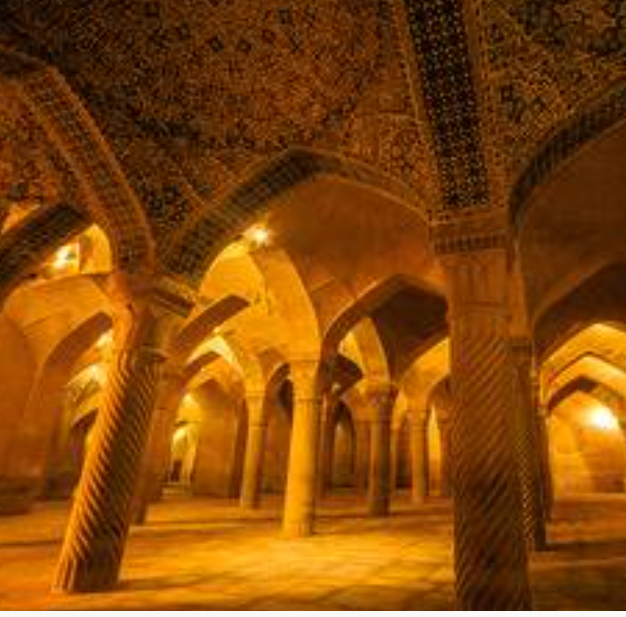
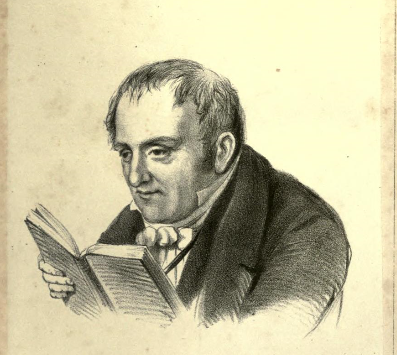
Two 19th cent. Images of Joseph Wolff (d.1862) and a glimpse of the Vakil Mosque in Shiraz.
Miscellaneous Notes regarding the Bab and the Literary and Intellectual Milieu of Early Qajar Shiraz.
Stephen Lambden UC Merced,
In Progress and under correction - Last updated 25-02-2022,
In order to throw some light of the literary milieu of the birthplace and main residence of the Bab between 1819 and the mid. 1840s, the following notes will be gradually completed, supplemented and commented upon in the light of a source-critical analysis of the revelatory Persian and Arabic writings of the Bab. While the Bab claimed, like the prophet Muhammmad, to be an ummi (loosely, `unlettered', `uneducated') prophet and mazhar-i ilahi (Manifestation of God) he did cite and was influenced by the massive literature of the Shi`i Islamic country into which he was born and the Persiante literary culture of Shiraz and elsewhere in what is today Iran.
A very useful glimpse into the intellectual milieu of early 19th century Shiraz can be gained by an analysis of the interactions between the German-born Jewish convert to Catholicism then Protestant, Anglican Christianity, Joseph Wolff (1795-2 May 1862) and persons he visited in early Qajar era Shiraz. A somewhat eccentric though courageous missionary and one-time student of oriental languages at Cambridge (UK), Wolff met and had spirited dialogue with Jews, Christian and Muslims of various kinds resident in Shiraz and elsewhere in the mid. 1820s (and later). In the third volume of his 1829 Missionary Journal of the Rev. Joseph Wolff, Missionary to the Jews (London: James Duncan + L.B. Seeley & Sons. 1829, pp. 53-54). Wolff lists a wide range of Persian and Arabic books that were the object of study in Shiraz in the 1820s among learned Muslims. In the sometimes very poor transliteration of Wolff, we may tentatively note our understanding of the following thirty-five or so listed Persian and Arabic works (22 Persian and 13 Arabic works) mentioned in his Missionary Journal. I have added a few clarificatory details and bibliographical notes. On attempting to identify the Perian and Arabic sources communicated to Wolff I shall include brief notice of select 19th century and later publications and translations of these poetical, historical and religious texts. Hopefully this will encourage students of the writings of the Bab to enter and identify with the literary universe into which he was born.
Persian and Arabic books in the third volume of the 1829 Missionary Journal follow along with a few clarificatory notes and select modern publications details:
The Twenty-two (largely) Persian works listed by the Muslim informants of Joseph Wolff.

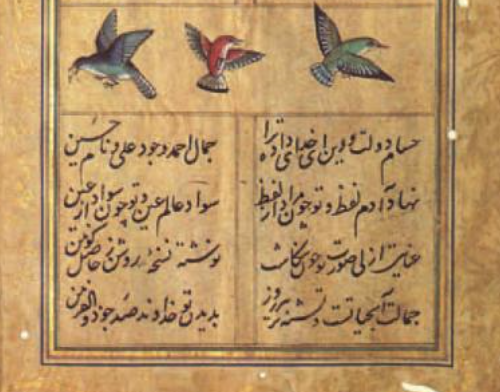
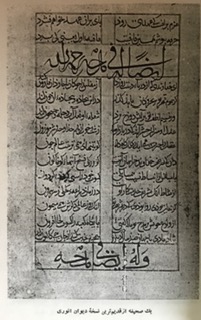
Dīvān-i Anvarī - `Ali ibn Muhammad Anvārī (b. Abivard.Turkmenistan c. 1126 CE -d. Balkh Afghanistan, c.1189 CE).
انورى، اوحد الدين،
[1] “Anware” [sic.] = Kulliyāt-i Anwārī + Dīvān-i Anwārī = Poetical works of `Ali ibn Muhammad Awḥad al-Dīn, Anvarī (d. ca. 585/1189-90).
"Anvari's poetry was widely read in his time and in the next centuries. We even find allusions to verses and tales from his Dīvān in the poetry of the greatest mystical poet who ever wrote in Persian, Maulana Jalaluddin Rumi ( 1207-73), who grew up in Balkh, where Anvari spent most of his life. Anvari's qasīdas became models for all later poets, and as late as the nineteenth century the major Persian poets continued to imitate the zamīn - the meter and rhyme scheme - of his most famous qasīdas" (Annemarie Schimmel in Anvari's Divan, 1983: 65),
ديوان انورى / Dīvān-i Anvarī or Anwārī - Printed editions
- كليات / Kullīyat / Dīvān Tabrīz, 1266/ 1849 or 50. 381 pages.
- كليات نظم انورى / Kullīyat-i naẓm-i Anvārī, Cawnpore, Kānpūr : Maṭbaʼ, 1897. 769 pages. See HathiTrust Digital Library :
- https://babel.hathitrust.org/cgi/pt?id=mdp.39015043628539&view=1up&seq=1
- Dīvān-e Anwārī. ed. Sa'id-e Nafisi. Tehran: Amir Kabir, 1337 Sh./1958.
- Dīvān-i Anwārī, ed. Muhammad Taqi Mudarris Ridawi, vol. 1, Qasā'id. Tehran, 1337 Sh./1958; vol. 2. Muqatta'āt, ghazaliyyāt, rubā 'iyāt .Tehran, 1340 Sh./ 1961.1347 Sh./1968.
- منتخبات از قصايد انورى : (بعد حذف و اضافه) / Muntakhabāt az qaṣāyid-i Anvarī baʻd ḥadhf va idāfah (= Selections from qasāid-i Anwarī ...). Bombay : Sharafuddin & Sons, 1966. 63 pages.
- Dīvān-i Anwārī. Tehran: Shirkat-i Intishārāt-i ʻIlmī va Farhangī, 1364/1986.
- Dīvān-i Anwārī. Introduction Saʻīd Nafīsī. Tehran: Intishārāt-i Nigah, 1376/1997. 742 pages.
- ديوان انورى Diwan-i Anwārī . ed. Saʻīd Nafīsī; Parvīz Bābāyī. Tehran: Nigāh, 1389/ 2010.
Awḥad al-Dīn Anvarī; ed. Saʻīd Nafīsī; Farīd Fatḥī
- Dīvān-i Anvarī : shāmil : qaṣīdahʹhā, ghazalʹhā, qiṭʻahʹhā, rubāʻīʹhā. Tehran: : Intishārāt-i Sunāyī, 1397/ 2018 or 2019. 807 pages.
ابو الحسن حسينى فراهانى، Abū al-Ḥasan Husaynī Farāhānī, et al.
- شرح مشكلات ديوان انورى . Sharh Mushkilat-i Diwan-i Anwārī. Tehran: Dānishgāh-i Tihrān, 1340/1961.
Auhaduddin Anvarī / Annemarie Schimmel; Stuart Carey Welch.

- Anvari's Divan: A Pocket Book for Akbar ; a Dīvān of Auhaduddin Anvari, copied for the Mughal emperor Jalaluddin Akbar (r. 1556-1605) at Lahore in A.H. 996/A.D. 1588. Now in the Fogg Art Museum of Harvard Univ. New York : Metropolitan Museum of Art, 1983. 142 pages.
Smith, Paul
-
Divan of Anvari. Victoria, Australia: CreateSpace Independent Publishing Platform: 2018, 212 pages. Translation & Introduction Paul Smith Ahad-ud-din Anvari Abeverdi (1126-1189) was a court poet of the Seljuk sultans. Jami composed a ruba’i where he names him, along with Firdausi and Sadi as one of the ‘three apostles’ of Persian poetry.
Note also Anvari's `The Tears of Khorasan'. translated by William Kirkpatrick in 1785, E. H. Palmer, trans. in A. J. Arberry ...
Edward Granville Browne (d. 1926).
- A Literary History of Persia. Volume II. Cambridge, 1902+1928), 364-94. Browne here draws upon the monograph on Anvari of Valentin A. Zhokovskii (1858-1918), `Materials for a Biography and Characteristic Sketch; `Alī Awhadu'd-Din Anwarl (St. Petersburg. 1883) summarizcd by Wilhelm Portsch in Literaturblatt für Orientalische Philologie (Leipzig. 1884·5)), II: 16. (so Schimmel in Anvari's Divan: 1983: 68).
[2] “Khakane” [sic.] = خاقانى، افضل الدىن شروانى، Afdal al-Dīn Bādil Ibrāhīm ibn ʿAlī Khāqānī Shīrvānī, (b. Shīrvān [now Azerbayjan] c. 1106, - d. Tabriz, c. 1190), the son of a Muslim and a Nestorian Christian woman.
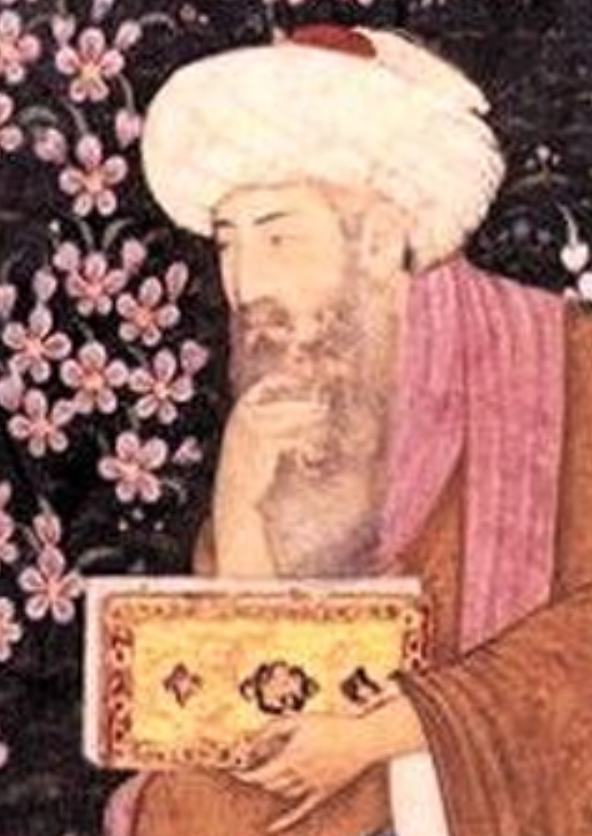
Afdal al-Dīn Ibrāhīm ibn ʿAlī Khāqānī Shīrvānī (d. Tabriz, 1190 CE), Image edited from Toos foundation
Khāqānī was a Persian poet, famous for his sometimes complex, difficult or abstruse court poems, satires, and epigrams. He he took his pen-name while at the court of the ruler or Shīrvān Shah, initially the khāqān (“Regal”), Manūchehr. He is especially famous for his Ḥabsiyya (prison poetry or “jail ballad”) a Mathnavī (poem in rhyming couplets) and another Mathnavī, the five part, around 3000 verse, poetical travelogue of his pilgrimage to Mecca entitled Tuḥfat al-ʿIrāqayn (“Gift of the Two Iraqs”= loosely “Persia” and Iraq).
“Of these qaṣidas and tarjiʿāt, nearly two-thirds are panegyrics. Most of them are profane, but some are in praise of the Prophet (naʿtiyas). These naʿtiyas in particular, but many of his other panegyrics as well, more specifically those dedicated to mystical and religious figures, have an ethical and pious content (zohdiyas).” (from Beelaert EIr.).
Dīvān-i Khāqānī
- ديوان حسان العجم افضل الدين ابراهيم بن على خاقانى شروانى / Dīvān-i Ḥassān al-Aʻjam Afz̤al al-Dīn Ibrāhīm ibn ʻAlī Khāqānī Shirvānī. ed. ʻAlī ʻAbd al-Rasūlī. : Kitābkhānah-ʼi Saʻādat, 1317/1938 + Reprinted Tehran: : Kitābkhānah-ʼi Khayyām, 2537. 1978. 11, 979 pages.
- Dīvān-i Khāqānī : guzārish-i dushvārīhā. ed. comp and annotation, Mīr Jalāl al-Dīn Kazzāzī, Tehran: Markaz, 1999. 963 pages.
Afdal al-Dīn Shirvānī Khāqānī
- تحفت العراقين = ختم الغرايب / Tuḥfat al-ʻIrāqayn = Khatm al-gharāyib. Zabān va adabīyāt-i Fārsī, 45. ed. ʻAlī Ṣafarī Āqʹqalʻah. Tehran : Mīrāth-i Maktūb, 2009. 64, 830, [8], 6 pages.
ʻAbbās Māhyār,
-
Sharḥ-i mushkilāt-i Khāqānī. 3 vols. Karaj : Intishārāt-i Jām-i Gul, 1382 /2003 or 2004.
Muhammad Ridā Barzgar Khāliqī
- شرح ديوان خاقانى : همراه با مقدمه، تلفظ واژههاى دشوار، درستخوانى، زيباشناسى و شرح ابيات / Sharḥ-i Dīvān-i Khāqānī : hamrāh bā muqaddamah, tallafuẓ-i vāzhahʹhā-yi dushvār, durustʹkhvānī, zībāshināsī va sharḥ-i abyāt. Tehran: Tihrān : Zavvār 2008; 2nd printing : Zavvār, Zamistān 1390 / 2012.
Maʻṣūmah Maʻdanʹkan;
-
بزم ديرينه عروس : شرح پانزده قصيده از ديوان خاقانى = Bazm-i dīrīnah-i ʻarūs : sharḥ-i pānzdah qaṣīdah az dīvān-i Khāqānī. Tehran: : Markaz-i Nashr-i Dānishgāhī, 1372/ 1993. 547 pages.
See further :
- Mīr Jalāl al-Dīn Kazzāzī, خاقانى شروانى / Khāqānī Shirvānī. : Daftar-i Pizhūhishhā-yi Farhangī, 1387/ 2008 or 2009. 108 pages.
- Rypka, Jan (2011). History of Iranian Literature. Springer.
- Khaqani". Encyclopedia Britannica.
- Beelaert, Anna Livia, “ḴĀQĀNI ŠERVĀNI (or Šarvāni)” in Eir. Vol. XV/ 5, pp. 521-529.
Alireza Korangy,
- Development of the ghazal and Khaqani's contribution : a study of the development of ghazal and a literary exegesis of a 12th c. poetic harbinger. Thesis. Wiesbaden : Harrassowitz, 2013; idem,
- Khaqani, poet-philosopher of medieval Persia : the life and writings. London : I. B. Tauris, 2016.
[3]”Khamsae Nasaama” [sic.], خمسه نظامى گنجوي ميرزا على قلى خوى = the Khamseh. خمسه, or "Quintet" or “The Quintuplet”, the five narrative poems of Elyās Yūsof Niẓāmī Ganjavī, Mīrzā ʻAlī Qulī Khūʼī (b. Ganja, Azerbayjan, c. 1141 - d. Ganja, 1209).
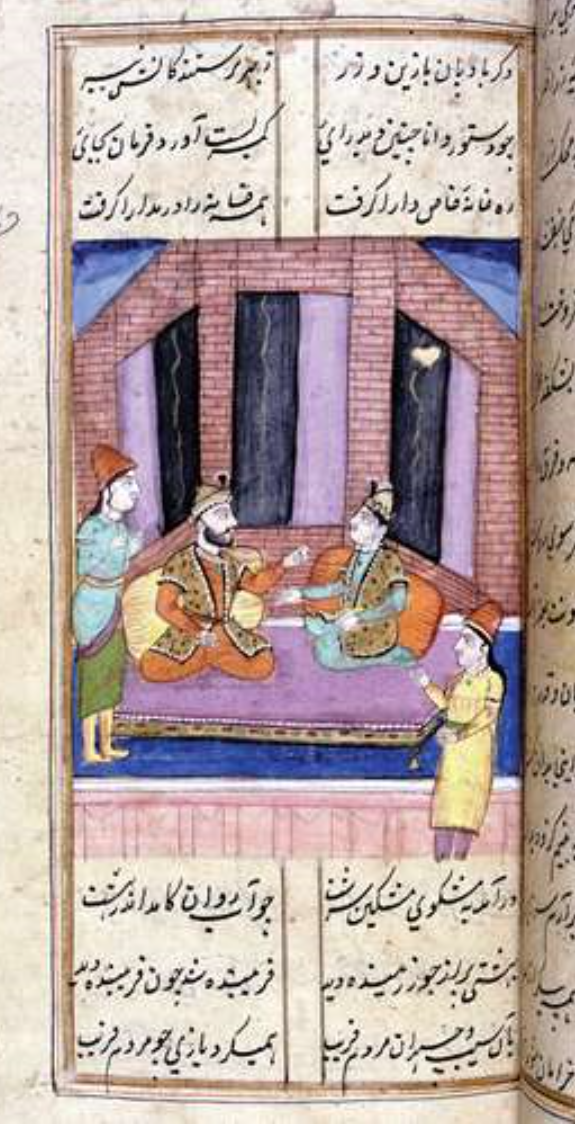
Niẓāmī reciting the story of Alexander...
Also known as the Panj Ganj, پنج گنج, ("Five Treasures"), this constitutes a pentalogy of around 30.000 mathnavī or rhymed couplets. The five portions are :
- مخزنالاسرار 1, Makhzan al-asrar, "The Treasury of the Mysteries"
-
خسرو و شیرین 2 Khusraw va Shirin "Khrosrow and Shirin". See further No. 8 below,
-
3 لیلی و مجنون Layli va Majnun "Layli and Majnun" the two originally Arab lovers "Night" and "Manness".
-
4 اسکندرنامه, Iskandah-Nameh. The Tale / Romance of Alexander [the Great] (356-333 BCE)" - for some a proto-Islamic warrior and prophet figure... See Niẓāmī Ganjavī; Euangelos Venetēs, The Persian Alexander : the first complete English translation of the Iskandarnāma, London : I.B. Tauris, 2018. x, 381+4 pages. See further and for an indication of contents World Cat :
-
https://www.worldcat.org/title/persian-alexander-the-first-complete-engl...
-
5 هفت پیکر Haft Paykar, "The Seven Beauties" - Niẓāmī Ganjavī, trans. Julie Scott Meisami, The Hayft Paykar. Oxford University Press, 1995. 307 pages,
[4]”Nechem Sanae” [sic.], Hakīm Sanāʼī =ائى الغزنوى، ابو المجد مجدود بن آدم، = Abū al-Majd, Majdūd ibn Ādam Sanāʼī al-Ghaznavī (b. Ghazna c. /1087- d. c. 525/1130). Also known as Khātam al-Shuʿarā ("The Seal of the Poets"),

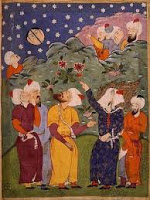
Dīvān-i Hakīm Abū al-Majd Majdūd ibn Ādam Sanāʼī Ghaznavi
- Dīvān-i Hakīm Abū al-Majd Majdūd ibn Ādam Sanāʼī-yi Ghaznavi. ed. Muhammad Taqi Mudarris-i Radavi, 3rd ed. Tehran: Kitab-Khaneh-yi Sanāʼī, 1362 Sh./1981.
The Didactic Poem Ḥadiqat al-ḥaqiqa... A mystical Mathnawi.
- Ḥadiqat al-ḥaqiqa wa-shariʿat al-ṭariqa (The Garden of Truth and the Law of the Right Path).
The Ilāhi-Nāma ("The Divine Book"),
Kārnāma-yi Balkh or Muṭāyaba-nāma ("The Book of Jest"). A secular poem of 433 couplets.
Select Articles
Franklin D. Lewis,
- “Reading, Writing and Recitation: Sanāʾī and the Origins of the Persian Ghazal,” Ph.D. dissertation, Chicago University, 1995.
Julie Scott Meisami,
- Medieval Persian Court Poetry, Princeton, 1987.
J. T. P. de Bruijn,
- Of Piety and Poetry: the Interaction of Religion and Literature in the Life and Works of Hakīm Sanā’ī of Ghazna, Leiden, 1983. Contains an extensive bibliography; Persian tr. Mehyār ʿAlavi and Moḥammad Javād Mahdavi as Ḥakim-e eqlim-e ʿešq, Mashhad, 1999.
See further EIr. Originally Published: May 17, 2012
-
"SANĀʾI, Majdud b. Ādam Ḡaznavi ..." EIr. :
[5] “Kolleat Sheikh Saade” [sic.] = The Kulliyāt ("Comprehensive Compendium") of Shaykh `Abd-Allah ibn Musharrif al-Din Saʻdī Shīrāzī (b. Shiraz c.1210 - d. Shiraz, d. 691/1292).
![]()
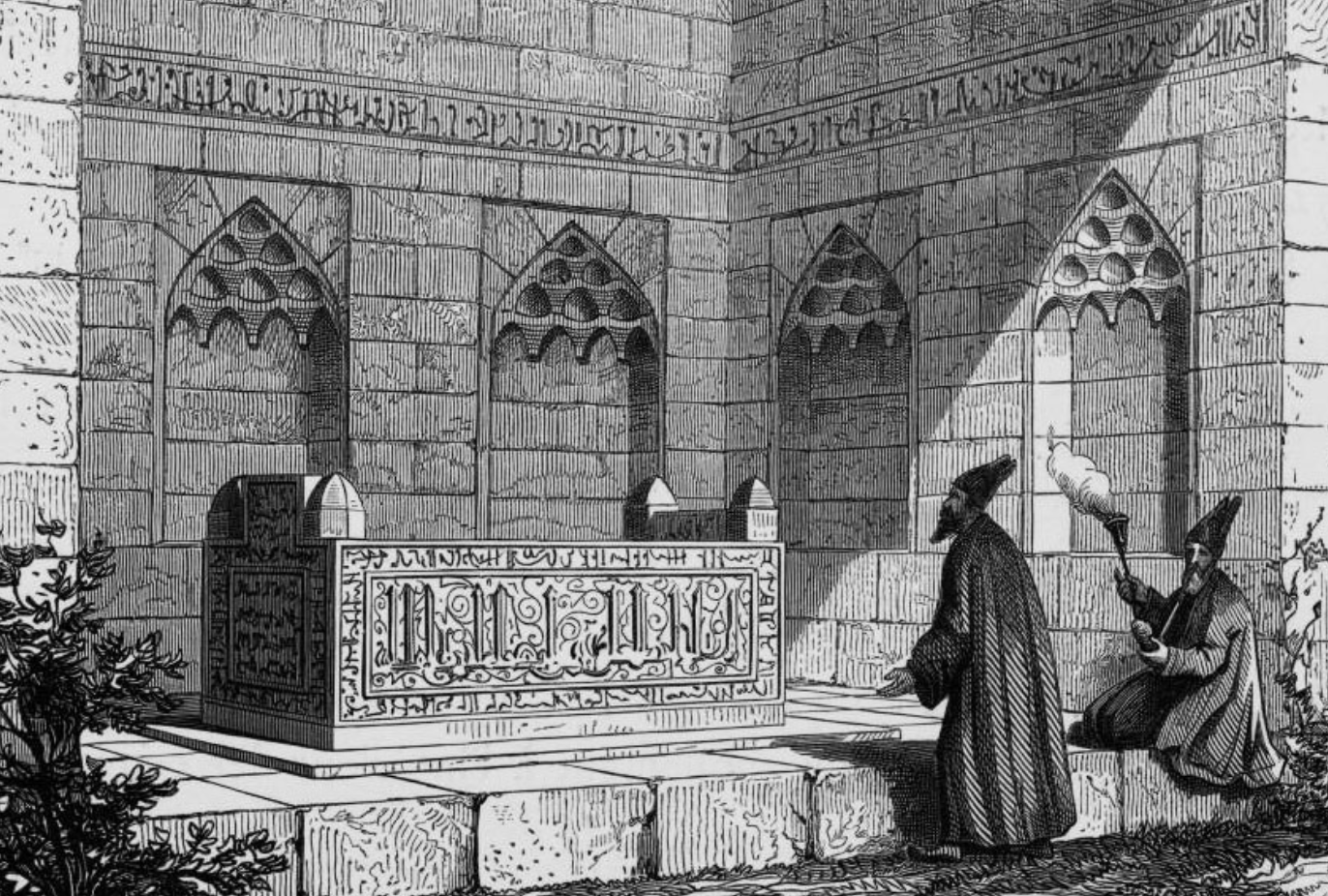
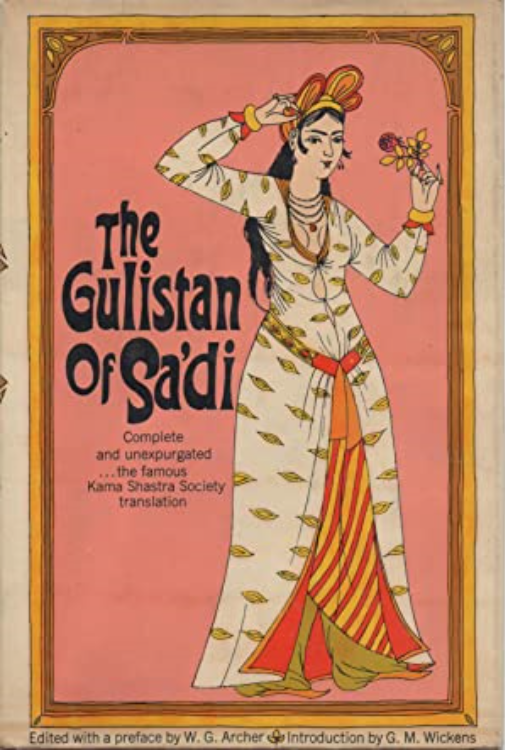
Tomb of Saʻdī - Pascal Coste, 1867.
This compendium is in more than twenty sections or divisions See Losensky EIr (below). Sa`di is especially famous for his Gulistan (Rose-Garden”), Bustan ( ), various Ghazals (“Lyrics”), and Qaṣīdahs ("Odes") as well as miscellaneous other writings. See
A. J. Arberry, Classical Persian Literature, London, 1958: 186-213.
See Paul Losensky. "SAʿDI, Abu Moḥammad Mošarref-al-Din Moṣleḥ b. ʿAbd-Allāh b. Mošarref Širāzi" in EIr.. January 1, 2000. Last Updated: February 1, 2012 :
"Gulistān" ("Rose-Garsen"), completed 656/1258 :
"Written in prose liberally sprinkled with verse in a variety of forms and meters, the Golestān follows the general themes and organization of the Bustān, but is grouped under eight (rather than ten) chapter rubrics, like the eight gates to paradise (G57): “On the Conduct of Kings” (41 stories), “On the Morals of Dervishes” (48 stories), “On the Excellence of Contentment” (29 stories), “On the Benefits of Silence” (14 stories), “On Love and Youth” (21 stories), On Frailty and Old Age (9 stories), On the Effects of Education (tarbiat, 20 stories), On Manners (non-narrative aphorisms and maxims)." Extract from EIr (see below).
- "Gulistān" -GOLESTĀN-E SAʿDI in EIr.
- http://www.iranicaonline.org/articles/golestan-e-sadi
Select English translations
Shekh Muslihu'd-din Sadi of Shiraz ; Trans. Edward B. Eastwick
- The Gulistan; or, Rose-Garden of Shekh Muslihu'd-din Sadi of Shiraz, Trubner & Co.,, Trubner's Oriental Series. 2nd ed. 1880.
Edward Rehatsek
-
The Rose Garden (Gulistan) (Masterpieces of Sufi Literature). Rep. Amrican ed. G.P. Putnam's Sons, New York NY. 1965.
Richard Burton Trans. & Illustrated by John Kettelwell,
- Tales from the Gulistan or Rose-Garden of the Sheikh Sa'di of Shiraz. Philip Allan & Co., Ltd., London, 1928.
"Bustan" ("The Orchard") بوستان, 4,100 mathnavī couplets completed in 655/1257. See G. Michael Wickens art in EIr. Vol. IV, Fasc. 6, pp. 573-574. December 15, 1990
[6] ”Dewaan Hafiz” [sic.] = Dīvān-i Ḥafiẓ.
The “Poetical Compendium” of Ḥāfiẓ of Shiraz (d.792/1390); شمسالدین محمد حافظ شیرازی Shams-al-Din Muhammad Ḥafiẓ-i Shirazī (ca. 715-792/1315-1390), celebrated Persian lyric poet,
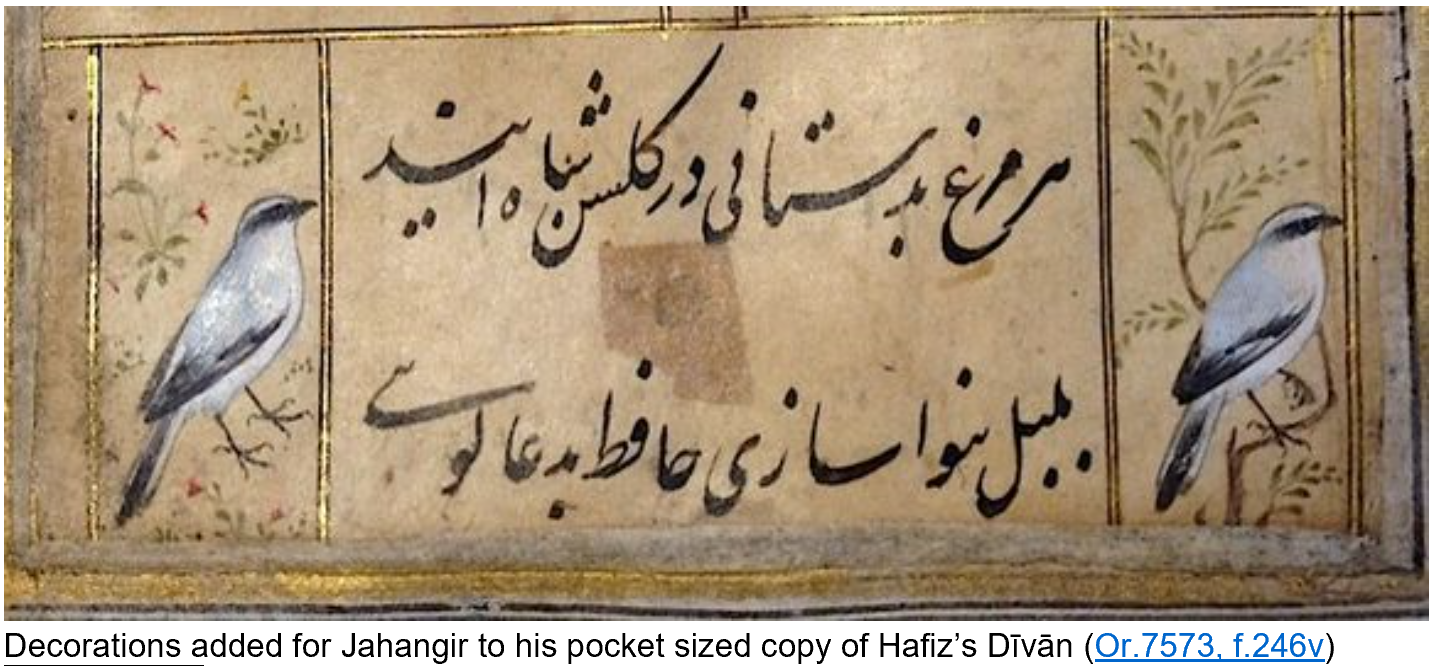
18 April 2013 - A rare commentary on the Divan of Hafiz
"Ḥāfiẓ" - Overview (Multiple Authors), 2002 +2012:
- EIr.Vol. XI, Fasc. 5, pp. 461-507 = http://www.iranicaonline.org/articles/hafe
English Translations of the poems of Ḥāfiẓ are scattered and numerous and of very varying quality. This is evident in the EIr article (cited above) and drawn on below.
Hafez x. Translations of Hafez in English by Parvin Loloi in EIr. Vol. XI, Fasc. 5, pp. 498-500 - Those early translators loosely chronologically listed below are not generally well-received in the EIr article (drawn on here); with the exception of that of Gertrude Bell which is often highly praised.
Sir William Jones (1746-94), translated a few poems including the “Turk-i Shīrāzī” ghazal, See his A Grammar of the Persian Language, Oxford, 1771.
- John Nott (1751-1825), Select Odes from the Persian Poet Hafez, London, 1787.
- Lieut.-Col. H. Wilberforce Clarke (1840-1905), trans. Dīvān (complete).
- Edward Byles Cowell (1826-1903),
- John Payne (1842-1916), The Poems Of ... Hafiz of Shiraz, London, 1901
- Gertrude Margaret Lowthian Bell (1868-1926).: Poems from the Divan of Hafiz, London, 1897; reissued as The Hafez Poems of Gertrude Bell, Bethseda, Md., 1995.
- Walter Leaf (1852-1927), Versions from Hafiz, An Essay in Persian Metre, London, 1898.
- Arthur John Arberry (b. Portsmouth, 1905 - d. Cambridge, 1969), “Orient Pearls at Random Strung,” BSO(A)S 11, 1946; Idem, “Hafiz and His English Translators,” Islamic Culture 20, 1946, pp. 111-28; 229-49' Idem, Fifty Poems of Hafiz, Text and Translations, Cambridge, 1947 (As in EIr.
- Paul Smith (b. 1945). Divan Of Hafiz, Melbourne, 1983.
- Julie. Scott Meisami, Lecturer in Persian at The Oriental Institute, Oxford + University of California, Berkeley.
- Elizabeth T. Gray, Jr., The Green Sea of Heaven: Fifty Ghazals from the Diwan of Hafiz, Ashland, Ore., 1995.
In some historical sources, the Bab is referred to as having quoted Hafez as a precocious child. Its place high up on this list might suggest that this was very possible or even probable.
[7] “Iaame Iaame” [sic.]. Perhaps the Mathnawi poem called Jam-i Jam or "Cup of Jamshid" ["World-Displaying Glass"] of Awhadi of Maragha or Isfahan (see EGB, LHP III:141)
Or a compendia of the writings of `Abd al-Raḥman Jāmī (d. Herat, 898/1492) ??;
[8] “Ferhada Shereen” [sic.] = شیرین و فرهاد / خسرو و شیرین = Shīrīn va Farhād / Khusraw va Shīrīn,

Tile depicting Khusraw and Shīrīn
A poetical romance between the Sassanian king Khusraw (Chosroes) II, Parvēz (r. 591-628) and/or the Parthian prince Farhād and an Armenian princess named Shīrīn (“Sweetness”) found within the massive fivefold Khamseh of Niẓāmī Ganjavī (see [3].2 above) ;
[9] “Shah Nameh : Jerdouse” [sic.] = the شاهنامۀ The Shāh-Nāmeh ("Book of Kings") of Manṣūr ibn Ḥasan Ḥakīm, Abu'l-Qāsim Firdawsī al-Ṭūsī (b. Bāzh or Pāj near al-Ṭūs, Khurasan, 329/ 940- d.c.411/1020), حکیم ابوالقاسم فردوسی توسی
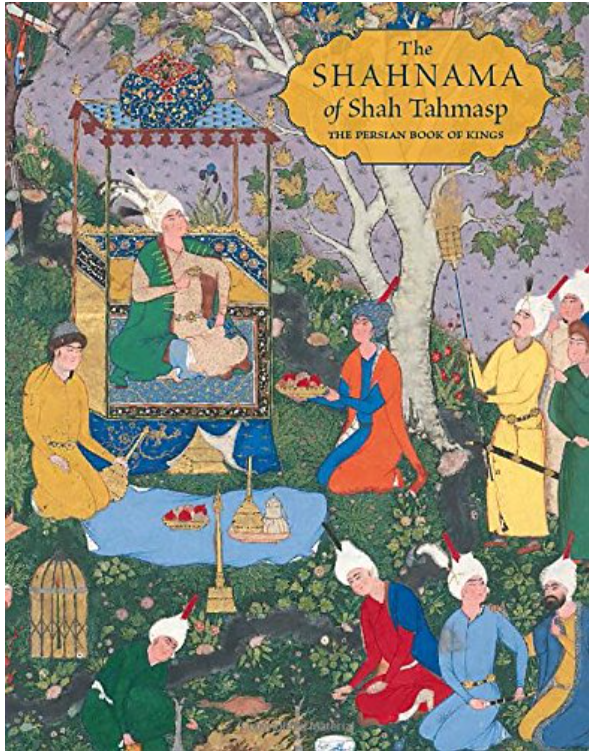
Select Editions and translations.
"The current standard edition of the poem [Shahnameh], which runs to nine volumes, includes over 50,000 lines... for an English reader.. that is over 100.000 lines long" (Davis, Shahnameh, 2006: xiii).
Firdawsi, Shāhnāmah / ed. trans. Jules Mohl
- Le Livre des Rois par Abou'lkasim Firdousi, traduit et commenté par J. Mohl. Publié par Mme. Mohl. / Firdawsī.; Jules MOHL; Mary Elizabeth MOHL, Madame. Paris: Mme. Mohl, 7 vols. 1876-8.
- Rep. Paris 1976,
Firdawsi, Jamshedji Dorabji Khandalawala; Julius Mohl; K.R. Cama Oriental Institute.
-
An introduction to the Shah-nameh of Firdousi from the French of Jules Mohl. Mumbai [Bombay] : K.R. Cama Oriental Institute, 2001. vii, 116 pages. Originally published: 1898. "Study on Shāhnāmah of Firdawsī based on Julius Mohl's, 1800-1876, Le livre des rois in French" (World Cat.).
Firdawsī.; Helen Zimmern; Lawrence Alma-Tadema [etchings]; Edmund Gosse [prefatory poem].
- Epic of kings : stories retold from Firdusi. London: T. Fisher Unwin, 1882. xlvii, 339 pages. Based upon Jules Mohl's French translation of: Shāhnāmah.
Firdawsī / ed. Evgenij Ė Bertelʹs et al. 1960s-1971 ["Moscow ed."]
- Shahnameh, 9 vols. Moskva Izdat. Vost. Lit., 1966-1971. In series "Pamjatniki literatury narodov Vostoka / Teksty / Bol'šaja serija, 2; Pamjatniki literatury narodov Vostoka / Teksty.; Bol'šaja serija",
-
Šāhnāma-i Firdausī : matn-i intiqādī / 1. Moskva : Nauka, 1963. vol. 3 (1965) In Silsila-i āthār-i adabī-i milal-i ḫāwar .; Bolšaja serija...
Firdawsī.; E Ė Bertelʹs; Niẓām al-Dīn Nūrī
-
شاهنامۀ فردوسى بر اساس چاپ مسکو / Shāhnāmah-ʼi Firdawsī bar asās-i chāp-i Muskū. Tehran: : Nashr-i Zuhrah, 1381/ 2002 or 2003. 697 pages. Persian - taḥt-i naẓar-i A. Birtils, bih kūshish-i Niẓām al-Dīn Nūrī Kūtanāyī.
Firdawsī / Ṭūmār Murshid ʻAbbās Zarīrī Iṣfahānī ; vīrāyish-i Jalīl Dūstkhvāh.
- شاهنامۀ نقالان : داستانهای پهلوانی ايرانيان در زنجيرهای از روايتهای سينه به سينه و سنتی / Shāhnāmah-ʼi naqqālān : dāstānʹhā-yi pahlavānī-i Īrāniyān dar zanjīrahʹī az rivāyatʹhā-yi sīnah bih sīnah va sunnatī. Tehran: Intishārāt-i Quqnūs, 1396 / 2017 or 2018. 5 volumes + 1 audio disc.
Firdawsī. / Djalal Khaleghi-Motlagh; Mahmoud Omidsalar; Abū al-Faz̤l Khaṭībī.
- Shahnameh, 5 + (7) vols. New York. 1988-1997 / 1987-2008. In series : Majmūʻah-ʼi mutūn-i Fārsī, silsilah-ʼi nū, shumārah-ʼi 1. Bibliotheca Persica، Niyū Yūrk : Bibliotheca Persica, ©1987-<2008. + Mazda Publishers. vol.1.includes introd. in English. See further World Cat. :
- https://www.worldcat.org/title/shahnamah/oclc/16924521&referer=brief_res...
-
ادداشتهاى شاهنامه / Yādʹdāshtʹhā-yi Shāhnāmah by خالقى مطلق، جلال. Djalal Khaleghi-Motlagh. New York : Persian Heritage Foundation, Bibliotheca Persica Press ; Winona Lake, Ind. : Eisenbrauns [distributor], 2001. Includes Concordance and Notes on the Shahnameh.
Translations +
- The Shah Nameh : an heroic poem. Containing the history of Persia from Kioomurs to Yesdejird ; that is, from the earliest times to the conquest of that empire by the Arabs. By Abool Kasim Firdousee. Carefully collated with a number of the oldest and best manuscripts, and illustrated by a copious glossary of obsolete words and obscure idioms: with an introduction and life of the author, in English and Persian ; and an appendix, containing the interpolated episodes, &c. found in different manuscripts. By Turner Macan, Persian interpreter to the Commander in Chief, and Member of the Asiatic Society of Calcutta Carefully collated with a number of the oldest and best manuscripts and illustrated by a copious glossary of obsolete words and obscure idioms: with an introduction and life of the author in English and Persian and an appendix ... By Turner Macan. Assisted by Hāfiz Ahmad Kabīr Pers. I,II,III,IV... Kalkatah/ Calcutta : The Baptist Mission Press, Circular Road, 1829. Rep. Tehran: 1365-67/1849-50. Very early publication.
-
Manṣūr b Ḥasan Firdawsī; Reuben Levy (trans.), iranist; Amin Banani (rev. trans.), The Epic of the Kings : Shāh-nāma, the national epic of Persia. London : Routledge & Kegan Paul, 1977 (Persian Heritage Series 2). 423 pages.
- The Shahnameh - The Persian Book of Kings, A New Translation by Dick Davis with a foreward by Azar Nafisi. USA: Viking /Penguin Books/ Mage Publishers, 1997, 2000+ 2004+ 2006. 886 pages.
- Sheila R Canby; [Ṭahmāsp, Shah of Iran], The Shahnama of Shah Tahmasp : the Persian book of kings. New Haven, Conn. ; London : Yale University Press, 2012. 287 pages. "One of the most voluminous epics of world literature, the "Shahnama" (or "Book of Kings") narrates the history of the ancient kings of Iran, from their mythical beginnings to the Arab conquest in 651 AD. This title presents 258 illuminated pages of this famous volume in colour and close to their original size". See Image above...
- Ahmad Sadri; Firdawsī.; Sheila R Canby; Hamid Rahmanian, Shahnameh : the epic of the Persian kings. New York : Liveright Publishing Corporation, a division of W.W. Norton & Company, 2017. xvii, 570 pages. Summary in World Cat. =
"Ferdowsi's classic poem Shahnameh is part myth, part history-beginning with the legend of the birth of the Persian nation and its tumultuous history, it contains magical birds and superhuman heroes and centuries-long battles. Written over 1,000 years ago, it was meant to protect Persian collective memory amidst a turbulent sea of cultural storms. Originally written in couplets, the translation and adaptation by Ahmad Sadri retells the mythological tales in prose format. The spectacular illustrations in this edition were created from elements culled from thousands of manuscripts, lithographs, and miniatures dating from the thirteenth through the nineteenth centuries, and each panel becomes a new work of art, an exquisite collage of traditional forms".
Select Articles.
Browne, Edward G., A Literary History of Persia vol. II:129-48,
See Djalal Khaleghi-Motlagh,
- "FERDOWSI, ABU'L-QĀSEM" EIr. http://www.iranicaonline.org/articles/ferdowsi-i 1999 updated January 26, 2012
Omidsalar, Mahmoud,
- Poetics and politics of Iran's national epic, the Shahnameh. Basingstoke : Palgrave Macmillan, 2011, Summary in World Cat. = "This book considers some of the Western interpretations of The Shahnameh - Iran's national epic, and argues that these interpretations are not only methodologically flawed, but are also more revealing of Western concerns and anxieties about Iran than they are about the Shahnameh". Abstract "This book considers some of the Western interpretations of The Shahnameh - Iran's national epic, and argues that these interpretations are not only methodologically flawed, but are also more revealing of Western concerns and anxieties about Iran than they are about the Shahnameh" (W.Cat.).
Lewis, Franklin,
- "The Shahnameh of Ferdowsi as world literature", in International Society for Iranian Studies, v. 48, no. 3. pp. 313-514. Abingdon: Routledge, Taylor & Francis Group, 2015.
[10] “Dabestan” = دبستان المذاهب the Dābestān-i madhāhib (The School of Religious Doctrines”) of Mīr Dhu’l-Fiqār Ardistānī (ca. 1026-81/1617-70).

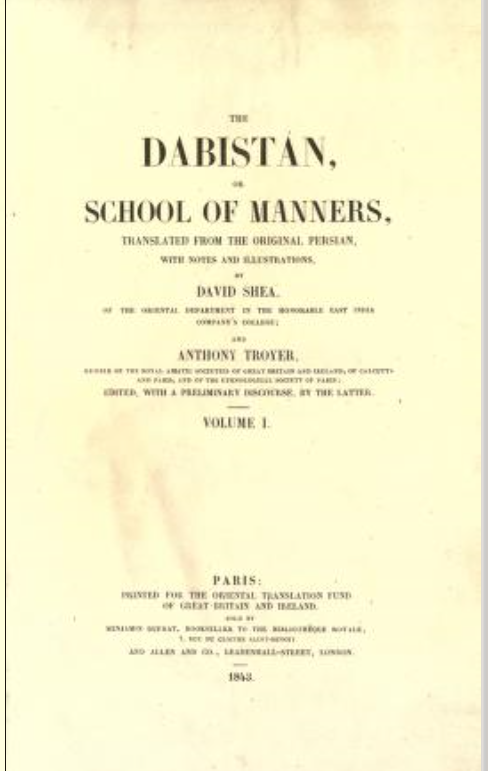
دبستان المذاهب
See article` DABESTĀN-E MAḎĀHEB’ by Fatḥ-Allāh Mojtabāʾī in EIr. Vol. VI/5, 532-534;
Original Persian Printings:
- هذا كتاب دبستان المذاهب = Hādhā Kitāb-i Dabistān al-madhāhib. Muḥsin Fānī; Ibrāhīm ibn Nūr Muḥammad. Bombay: Lithograph, 1267/ 1851 +1292/ 1875. 327 pages.
- دبستان مذاهب. Dabistān al-madhāhib, Lucknow : Munshī Naval Kishūr, 1877.Here attributed to فانى كشميري، محسن. Muḥsin Fānī Kashmīrī. 396 pages.
- دبستان مذاهب / Dabistān-i madhāhib. Kaykhusraw Isfandiyār; Muḥsin Fānī; ed. Raḥīm Ridāzādah-ʼi Malik. Tehran: : Kitābkhānah-ʼi Ṭahūrī, 2 vols. 1362 /1983 [= Adabiyāt-i dasātīrī, 1] Vol.1/ mujallad-i 1. Matn =Text; vol. 2 mujallad-i 2. Taʻlīqāt. Notes and commentary. Here the book is attributed by the editor to Mūbad Kaykhusraw Isfandiyār though often previously or commonly attributed to Muḥsin Fānī (see above and translations below).
-
Dābestān-i madhāhib
Select Translations
Early Victorian English translation in 3 vols. London, 1843. Authorship attributed to Muhammad Muḥsin Fānī (following William Jones) ...
Shea, David, & Anthony Troyer (eds.) / Mīrzā Muḥammad Fānī; David Shea; Anthony Troyer
- The Dabistan, or School of Manners, translated from the original Persian, with Notes and Illustrations, by David Shea the oriental department in the Honourable East India Company's College; and Anthony Troyer, member of the Royal Asiatic Societies of Great Britain and Ireland, of Calcutta and Paris, And of the ethnological society of Paris; edited, with a preliminary discourse, by the latter. Paris : Printed for the Oriental Translation Fund of Great Britain and Ireland. Sold by Benjamin Duprat, bookseller to the bibliothèque Royale, 7. Rue du Cloitre Saint-Benoit. And Allen and Co., Leadenhall-Street, London., 3 vols. 1843. cxcvii, 380 pages (Vol.1);
- The Dabistán: or, School of Manners: The Religious Beliefs, Observances, Philosophic Opinions and Social Customs...: of the nations of the East. Translated from the original Persian by David Shea and Anthony Troyer with a special introduction by A. V. Williams Jackson. by Fānī / Muḣammad Muḣsin, d. 1671 or 2. Shea, David, 1777-1836.
- PDf. https://archive.org/details/in.ernet.dli.2015.24735/page/n9/mode/2up
- PDf.https://ia600206.us.archive.org/31/items/dabistnorschoo01shea/dabistnors...
- https://ia600206.us.archive.org/31/items/dabistnorschoo01shea/dabistnors...
- Abridged edition Washington: M. Walter Dunne, 1901.
- Oriental Literature: Or, The Dabistan by Shea, David; Troyer, Anthony (translators). New York: Tudor Publishing Co, 1937. 8vo (medium). Translated from the original Persian. vii, 411 pages.
Sheth, Sudev,
- "Manuscript Variations of Dabistān-i Maẕāhib and Writing Histories of Religion in Mughal India" article in Manuscript Studies: A Journal of the Schoenberg Institute for Manuscript Studies, vol., 4 no.1 (2019), pp.19-41. Summary:
"ABSTRACT: A text that has found renewed interest among scholars of early modern India is the Persian compendium of religion called Dabistān-i Maẕāhib. Written between 1645 and 1658, the Dabistān presents a lively ethnographic and historical account of customs and habits of various major and minor religious communities in northern India during the heyday of the Mughal Empire (1526-1707). Written like a travelogue, it moves between various modes of description including mythical revelations, storytelling, ethnographic notes, and authorial commentary. The Dabistān-i Maẕāhib is also valuable because it is the earliest work outside of the Sikh literary tradition that contains first-hand accounts of the growing Sikh socio-religious movement established in Punjab during the sixteenth century. Focusing on this section titled "The Nanak Panthis", this article explores what translators, commentators, and historians have variously understood as comprising the original text. Since the early twentieth century, scholars have relied on later manuscript and print editions in their English translations and use of this work without necessarily reflecting on how these choices have preconditioned interpretive possibilities. My analysis of a recently discovered and earliest known manuscript copy of the Dabistān-i Maẕāhib from 1650 suggests that all of the later hand written and print editions, which have now become standardized through scholarly convention, omit certain details and even entire passages. This has major implications for how we have understood the genesis and transmission of the text, and perhaps more significantly, the social groups and historical moments depicted in this one-of-a-kind work" ( As cited World. Cat.).
The possible influence of the Dabistan on the writings of the Bab has yet to be examinbed in any detail.This subject first came to my attention in the 1970s when I ordered (through Oxford central library ILL service) the then scare Shea and Troyer printing of the Dabistan and read it through. I soon became aware of its very probable influence upon Babi-Baha'i sacred writings and aspects of its doctrinal universe....
[11] “Anwar Saheile” [sic.] = انوار سهيلى = Anwār-i Suhaylī (“Lights of the Canopus”; adapted in Persian from Kalílah va Dimnah (rooted in the fables of Bídpáí) as a `Mirror for Princes’ from India of Mulla Ḥusayn ibn `Alī, Ḥusayn Vāʻiẓ Kāshifī
See further "KALILA WA DEMNA (کلیله و دمنه)", a collection of didactic animal fables... in EIr. Vol. XV, Fasc. 4, pp. 386-397 Multiple Authors. Originally Published: December 15, 2010.Last Updated: April 20, 2012.
[12] “Rawsat Alsafaa” [sic.] = روضة الصفا في سیرة الانبياء والملوك والخلفاء = Rawḍat al-ṣafā’ fī sīrat al‑anbiyā’ wa’l‑mulūk wa’l‑khulafā’ of Muhammad ibn Khwāndshāh ibn Maḥmūd, Mīrkhwānd or "Mīrʹkhvānd" (d. 903/1498).
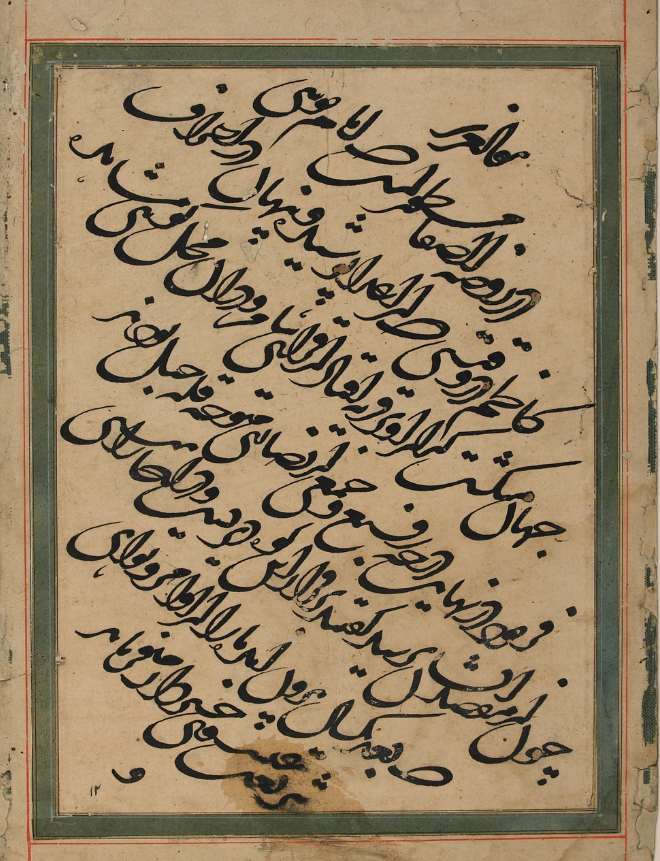

Section of Mirkhwand's "Rawzat al-Safa'" (Library of Congress) + Image from the Rehatsek printing. See below.
Muḥammad ibn Khāvandshāh, Mīr Khvānd
The Rawḍat al‑ṣafā (The Garden of Purity...)
According to Rosenthal the 13th century saw a "steady flow of Arabic and Persian universal histories" (Rosenthal 1968:148). Notable, however, among the pre‑Safavid chronicles is the Rawḍat al‑ṣafā fī sīrat al‑anbiyā’ wa’l‑mulūk wa’l‑khulafā’ (Garden of Purity respecting the Lives of the Prophets, the Kings and the Caliphs; 7+1 vols.) of the late Tīmūrid writer Muhammad ibn Khwāndshāh ibn Maḥmūd, Mīrkhwānd (d. 903/1498). Refer Storey, 1:92‑101 (342); Zaryāb, `preface’ [1:xff] Beveridge [Manz], `Mīrkhwānd..’ EI2 VII:126‑7; Quinn, 2000:14.
This lengthy work has a long opening section `On the beginning of creation, the stories of the Prophets (qiṣaṣ‑i payāmbarān), the circumstances of the Iranian kings and of the sages of old (ḥukamā‑ yi pīshīn)’ (ed. `Abbās Zaryāb,1:15‑198).2 It cites around forty Arabic and Persian histories and exists in numerous often confused manuscripts. Apparently lacking an autograph ms. variant texts are represented by several 19th century lithograph editions (Bombay, 1845, 1848; Tehran, 1853‑56; Lucknow, 1874;1883) some having been translated into Turkish, Latin and other European languages. The Rawḍat al‑ṣafā was supplemented and extended in Qājār times by Riḍā’ Qulī Khān Hidāyat (d. 1288/1871) as the Rawḍat al‑ṣafā‑ yi Nāṣirī.
Library of Congress - Fragment on the 7th Imam Musa al-Kazim (d.c. 183/799).
Select manuscripts and printed editions of the Rawḍat al-ṣafā’ :
- تارىخ روضة الصفا. - Tārīkh-i rawḍat al-ṣafā. Lithograph. 7 vols in 2 vols. (Vol.1. = Pts. 1-3 and vol.2 Pts. 4-7), Bombay: N.p., 1263 /1847. This is apparently the very first Lithograph printing of the Rawḍat al-ṣafā. This publicaton was completed on 15th Ramadan, 1263 AH = 27th August 1847 CE and was associated with Shiraz through a certain Sayyid Rida' al-Husayni al-Shirazi (see Rawdat ed. Jamshid Kiyānfar, vol.1: 44, citing the conclusion of this first lithograph edition).
- تارىخ روضة الصفا. - Tārīkh-i rawḍat al-ṣafā. Lithograph, Bombay : N.p., 1266/1850.
- جلد اول مشتمل بر پنج مجلد ار جمله هفت جلد تاريخ سابقه محمد خواند شاه ... بإهتمام ومراقبة مؤلف ومتمم ين تأليف شريف ... رضاقلى متخلص بهدايت ... vols. 10 vols. in 9. Ṭehran : [Publisher not identified], 1270-1274/ 1853-1857. Pts. 8-10 were written by Riz̤āʹ Qulī Khān Hidāyat, as a supplement to Rawz̤at ʾal-ṣafā, under the title Tārīkh-i Rawz̤at al-ṣafā-yi Nāṣirī. Copy in Edinburgh University Library (so World Cat.)
- کتاب تاريخ روضة الصفا = Kitāb-i Tārīkh-i Rawḍat al-ṣafā'. 7 volumes in 1. Lithograph, Bombay : [publisher not identified], 1271/1855.
-
تاريخ روضة الصفا / Tārīkh-i rawḍat al-ṣafā, مير خواند، محمد بن خواوندشاه. تصنيف مير محمد بن سيد برهان الدين خواوندشاه الشهير بمير خواند ؛ از روى نسخ متعدده مقابله گرديده و فهرست اسامى و اعلام و قبايل و كتب با چاپهاى ديگر متمايز ميباشد. هدايت، رضا قلي. ; Muḥammad ibn Khāvandshāh Mīr Khvānd; Riz̤ā Qulī Hidāyat = Mīr Muhammad ibn Sayyid Burhān al-Dīn Khāvand Shāh al-shahīr bi-Mīr Khvānd ; az rū-yi nusakh-i mutaʻaddadah-i muqābilah gardīdah va fihrist-i asāmī va aʻlām va qabāyil va kutub bā chāphā-yi digar mutamāyiz mībāshad 10 vols. [in 7 vols.] Tehran: : Kitābfurūshī-i Markazī or Markazī-i Khayyām Pīrūz, 1338-1339/1959-1960. Here vols 8-10 were written by Riz̤ā Qulī Khān Hidāyat, being a supplement to Rawz̤at al-ṣafā, under the title Tārīkh-i Rawz̤at al-ṣafā-yi Nāṣirī.
- تاريخ روضة الصفا فى سيرة الانبياء والملوک و الخلفا / Tārīkh-i rawz̤at al-ṣafā fī sīrat al-anbiyāʼ va al-mulūk va al-khulafāʼ. 10+ volumes in 15. Vols. 12-15 are the Qajar supplement by Riz̤ā Qulī Khān Hidāyat. ed. Jamshid Kiyanfar. Tehran: Intisharat-i Aṣāṭīr, 1380 / 2001-2002. World Cat. spells out the contents of vols 1-10 as follows.
- 1. Az ẓuhūr-i khalqat tā Shalūm ibn Dāvud --
- 1, 2. Az Sulaymān ibn Dāvud tā ufūl-i Sāsāniyān --
- 2-1. Dar sharḥ-i ḥāl-i payāmbar tā sāl-i haftum-i hijrat --
- 2-2, bakhsh-i 2. Vaqāyiʻ-i sāl-i hashtum tā sāl-i chihilum-i hijrat --
- 3. Sharḥ-i ḥāl-i aʼimmah-i aṭhār, Bani Umayyah, khulafā-yi ʻAbbāsī --
- 4-1. Az Ṭāhiriyān tā Saljūqiyān --
- 4-2. Az Khvārazmshāhiyān tā Āl-i Kart --
- 5. Mughūlān, Chūpāniyān, Īlkāniyān, Sarbidārān --
- 6, bakhsh-i 1. Amīr Taymūr Gūrakān --
- 6-2. Jānishīnān-i Amīr Taymūr --
- 7. Dar salṭanat-i sulṭān Ḥusayn Bāyqarā va z̲ikr-i badāyiʼ va ʻajāyib va gharāyib-i jughrāfiyā --
- 8. Ṣafavīyān va Afshāriyān --
- 9-1. Zandīyah, Qājārīyah tā pāyān-i jang-i avval-i Īrān va Rūs --
- 9-2. Dunbālah-ʼi salṭanat-i Fatḥ ʻAlī Shāh --
- 10. Dar salṭanat-i Muḥammad Shāh va Nāṣir al-Dīn Shāh Qājār.
_____
-
فهرست تارىخ روضة الصفا : فهرست اعلام و اماکن و کتب / Fihrist-i Tārīkh-i Rawḍat al-Ṣafā : fihrist-i aʻlām va amākin va kutub. : Kitābfurūshī-i Khayyām, 1351/1372. 16+615 pages, Contains an introduction by Muhammad Javād Mashkūr.
-
XX
English and select other partial translations of the Rawḍat al-ṣafā’ :
The Paris 1843 Persian edition and partial trans. as Histoire des Samanides par Mirkhond...
- Mirkhvand. Tarikh-i rawzat al-safa. Translated by E. Rehatsek as Rauzat-us-safa or, Garden of Purity. 2 Vols. Ed. Forster Fitzgerald Arbuthnot Arbuthnot. Oriental Translation Fund, New Series 1. London: Royal Asiatic Society, 1891-2 -ed by for the Royal Asiatic Society, in two parts.
Edward Rehatsek (b. Ilok, Hungary, now in Croatia, 1819 – d. Bombay, 11 December 1891) was among other things a Professor of Latin and mathematics at Wilson College Bombay. In 1891‑2 he published his partial English translation of the first volume of the Rawḍat al‑ṣafa. This is an English rendering of the Bombay Lithograph printing of 1271/1854 and includes passages not found in, for example, the recent editions such as the Tehran 1375 Sh./ 1996 printing
-
The Rauzat-us-safa ; or, Garden of purity..by Muḥammad ibn Khāvandshāh Mīr Khvānd. Pt. I. v. 1-2. The histories of prophets, kings, and khalifs.--pt. II. v. 1-2. The life of Muhammad the apostle of Allah.--pt. II. v. 3. The lives of Abu Bakr, O'mar, O'thmân, and A'li, the four immediate successors of Muhammad the apostle
- Muhammad Bin Khavendshah Bin Mahmud, The Rauzat-Us-Safa; Or, Garden of Purity: Containing the Histories of Prophets, Kings, and Khalifs (E. Rehatsek, trans., F. F. Arbuthnot, ed.) i (1894).
PDf, Rehatsek translation, Rauzat-us-safa
French Trans. 1894.
- Rauzat-us-safa (Jardin de Purete): Bible de l'Islam, ou l'Histoire Sainte suivant la Foi Musulmane, par l'Historien Persan Mirkhond. Traduite de l'Anglais par E. Lemairesse. Imprimerie Deslis Freres, Toures, 1894. xiv, 358 pages.
[13] “Habib alsegar” [sic] حبيب السيّر... = [Tārīkh-i] Habīb al-siyār fī akhbār afrād bashar (The Beloved of Histories regarding the traditions of the most singular of mortals) of Ghiyāth al-Dīn ibn Humām al-Dīn Khwāndamīr (d. c. 941/ 1534-5). Dating to c. 930/1524.
Mīrkhwānd’s grandson the Persian historian Ghiyāth al-Dīn, Khwāndamīr summed up and supplemented his grandfather’s Rawḍat al-ṣafā’ in his Khulāṣat al-akhbār (905/1499). Khwāndamīr also completed his grandfather’s Rawḍat al-ṣafā’ writing a seventh volume and a conclusion He also authored another more extensive, multi-volume general history covering the period from the creation until just after the death of the Safavid Shāh Ismā’īl (d. 930/1524 CE). This latter work is entitled Tārīkh ḥabīb al-siyar (see above).
[14] “Atesh Keda” [sic.] = Ātish Khadah ?? (“the [Zoroastrian] Fire of God”?) = Ātish va Ātishkadah of Khudādād Khanjarī ?? =
[15]”Ketab Aashek” [sic.] = ? Kitāb al-Shaykh `Aṭṭār, Farīd al-Dīn, Muhammad ibn. Ibrahim Nīshābūrī (c. 513/1119- 627/1230). Most probably the Manṭiq al-Ṭayr ("Conference-Parliament of the Birds") of Farīd al-Dīn`Aṭṭār (d. c. 927/1229 or 1230)
Select works of Muhammad ibn Ibrahim Farīd al-Dīn `Aṭṭār (d. c. 927/1229 or 1230).
Perhaps one of the many works of `Attar perhaps his centrally important Manṭiq al-Ṭayr منطق الطیر or Maqāmāt al-Ṭuyūr مقامات الطیور. A useful coverage of the Manṭiq al-Ṭayr is contained in the N. Hani (ed) The Biographical Encyclopaedia of Sufis (New Delhi Samp & Sons 2002).pages 81-8 A portion of this reads as follows ...
"The Sufi order which Attar is credited with having created and probably developed and which certainly carries the tradition of his concentrating, carries out exercises destined to produce and maintain the harmony of the participant with the wh le of creation and it closely resembles the other Orders of Suflsm, the larikas. The stages of development of a Sufi wile they may take a different sequence in different individuals, are portrayed in the Parliament of the Birds [Mantiq al-Tayr or "Conference of the Birds"]
The birds, who represent humanity, are called together by the hoopoe, the Sufi, who proposes that they should start on a quest to find their mysterious King. He is called Simurgh and he lives in the Mountains of Qaf.
Each bird, after at first being excited by the prospect of having a King, begins to make excuses as to why he should not himself take part in the journey toward the hidden King.
The hoopoe, after hearing the plea of each [p. 82] replies with a tale which illustrates the uselessness of preferring what one has or might have to what one should have. The poem is full of the Sufi imagery and has to be studied in detail in order to be properly understood.
The Ring of Solomon, the nature of Khidr the hidden guide, anecdotes of the ancient sages, fill its pages.
Eventually the hoopoe tells the birds that in the quest they have to traverse seven valleys.
First of all is the Valley of the Quest, where all kinds of perils threaten and where the pilgrim must renounce desires. Then comes the Valley of Love, the limitless area in which the Seeker is completely consumed by a thirst for the Beloved. Love is followed by the Valley of Intuitive Knowledge in which the heart receives directly the illumination of Truth and an experience of God. In the Valley of Detachment the traveller becomes liberated from desires and dependence.
In the inter-change in which the hoopoe deals with the nightingale. Attar exposes the uselessness of ecstatics, mystics who follow romance for its own sake, who intoxicate themselves with hearings, who indulge ecstatic experience and are out of touch with human life.
The passionate nightingale came forward, beside himself with fever. In each one of his thousand varying chirrupings he gave vent to a different mystery of meaning. He spoke so eloquently of mysteries that all the other birds fell silent. He said:
"I know the secrets of love. Throughout the night I give my love call. I myself teach the secrets; and it is my song which is the lament of the mystic flute and which the lute wails. It is I who set the Rose in motion and move the hearts of lovers. Continously I teach new mysteries, each moment new notes of sadness, like the waves of the sea. Whoever hears me loses his wits in rapture, contrary to his normal way. When I am long bereft of my love the Rose. I lament unceasingly.. ..And when the Rose returns to the world in Summer. I open my heart to joy".
My secrets are not known to all—but the Rose knows them. I think of nothing but the Rose; I wish nothing but the ruby Rose.
To reach the Simurgh, that is beyond me— the love of the Rose is enough for the nightingale. It is for me that she flowers ...can the nightingale live but one night without the Beloved?"
The hoopoe cried:
"O laggard, busy with the mere shape of things! Leave off the pleasures of seductive form! The love of the face of the Rose has merely driven thorns into your heart. It is your master. However beautiful the Rose, the beams vanishes in a few days. Love for something so perishable can only cause revulsion in the Perfected Man. If the Rose's smile awakens your desire, it is only to hold you ceaselessly in sorrow. It is she who laughs at you each Spring and she does not cry—leave the Rose and the redness."
Commenting upon this passage, one teacher remarks that Attar refers not only to the ecstatic who does not take his mysticism further than rapture. He also means the ecstatic' s parallel, the person who feels frequent
and incomplete love and who, although deeply affected by it. is not regenerated and altered by it to such an extent that his very being undergoes a change:
"This is the fire of love which purifies, which is different whenever it occurs, which sears the marrow and makes incandescent the kernel. The ore separates from the matrix and the ... see further volume cited.
[16] “Ketab Sheikh [Shaykh] Utar, [sic] or `Aṭṭār = Shaykh `Aṭṭār = رید الدین عطار نیشاپوری , Farīd al-Dīn, Muhammad ibn Ibrahim Nīshābūrī c. 513/1119- 627/1229 or 1230] "in 114 volumes". Wolff refers to him as one “highly esteemed” by the Sufis. Like Wolff's informants, legend associates `Aṭṭār with the number 114 (cf. the number of Qur'anic suras). Some have it that he wrote 114 works or even lived 114 years (see Paul Losensky, 2009:6). The reference to the 114 might also allude to the biographical sections or divisions within some recensions of the Tadhkirat al-Awliyā of `Aṭṭār Nīshābūrī c. 513 / 1145- c. 627/1229 or 1230).
`Aṭṭār, Farīd al-Dīn, Muhammad ibn. Ibrahim (c. 513/1119- 627/1230)
Select works of Farīd al-Dīn `Aṭṭār Nīshābūrī
- Diwan
- Mukhtar-Namah
- Musibat-namah:
- Ilahi-Nameh
- Tadhkirat al-Awliyā
"Tadhkirat al-Awliya: an extensive prose work which contains the [roughly 114] biographies and sayings of Muslim mystics. It ends with a biography of Halladj, who plays such an extensive part in the works of the second group. Other biographies—over 20 in number have been added in some manuscripts. In these, as also in his epics, 'Attar has treated his sources freely, and has often altered them in the light of his own religious ideas. For the numerous Turkish studies and translations, see the article Attar in IA; in addition Sa'id Nafisi 1 10-112. The text of the edition by R.A. Nicholson, he Tadhkiratu M-awliya of Shaikh Faridu'd-din 'Attar, London-Leiden, 1905-1907, Persian Historical Texts 3 and 5, is not always trust-worthy. Other editios in Sa'id Nafisi 112 and in the above mentioned catalogues." (extract from the `Aṭṭār, Farīd al-Dīn... entry in the N. Hani (ed.) 2002 Biographical Encyclopaedia of Sufis (see below), p.77 (item 9). .
- Manṭiq al-Ṭayr منطق الطیر or Maqāmāt al-Ṭuyūr مقامات الطیور.
See on Farīd al-Dīn `Aṭṭār Nīshābūrī See :
- Ritter, Helmut. (1986), 「`Aṭṭār」, Encyclopaedia of Islam, New ed., vol. 1: 751-755.
The Bab and `Aṭṭār (Nos 15 and 16 above).
A careful study of the writings of the Bab - especially his Qayyum al-asma' and Persian Bayan etc - shows that he was intimately familiar with and influenced by the bird imagery of the Mantiq al-Tayr and certain major figures spoken about and cited in the Tadhkirat al-awliya' , especially al-Hallaj of Ana al-Haqq fame and Rabiya certain of whose sayings he quite often cited or alluded to )see Lambden 1980s/2002 PhD thesis).
[17] “Aseere Sheik Nosbakhsh [sic.] which speaks about the Soffees” = The al-Sirah / Asrār-i Shaykh Nūrbakhsh which speaks about the Sufis... = محمد بن عبد الله الموسوئی قہستانی = Sayyid Muhammad Nurbakhsh Qahistani (b. Ka'in Kuhistan, 795/1392- d. c. 889/1464-5). He was a prolific writer in Arabic and Persian and founding figure of the Nurbakshiyya Sufi order, an offshoot of the Kubrawiyya Sufi order,
N. Hani ed.
- Biographical Encyclopaedia of Sufis (Central Asia and Middle East). esp. H Algar, article "Nurbakhsh, Sayyid Muhammad b. Muhammad b. 'Ahd Allah (1392-).." pp, 363-368, New Delhi Samp & Sons 2002.
"The most accomplished disciple of Nurbakhsh was Shaikh Muhammad Lahidji (d. 921/1515), author of the Mafatih al-i'djaz fi sharh-i Gulshan-i-raz, one of the most widely read later Sufi texts in Persian. He established a Nurbakhshi khanakah in Shiraz, known as the Nuriyya, which was visited by Shah Isma'il. The direction of this khanakah was inherited by an apparently unworthy and dissolute son, Shaikh-zada Ahmad Lahidji, after whom there is no trace of this line of Nurbakhshi transmission" (so Algar. 2002: 365).
Note the later Dhahabiyya Sufi order which was centered in Shiraz - see R. Gramlich, Die Schiitischen Derwishorden Persiens 1965 Vol.1. pp.14-26,
See Bashir, S:
- "Messianic Hope and Mystical Vision: The Nurbakhshiya Between Medieval and Modern Islam (Studies in Comparative Religion), "University of South Carolina Press", October 2003
[18]”Ketabe Sheikh Ali Kobe about Soffees” [sic.]
[19] Masnawee, the Gospel of the Soffees” [sic.] = The Mathnavī of Jalāl al-Dīn Rūmī (b. Vaxsh, 604/1207- d. 672/ 1273).
The Mathnavī of Jalāl al-Dīn Rūmī (d. 672/1273) is a massive six book (2500+ lines) mathnavi Sufi poem widely regarded as the "Persian Bible". In both the east and the west, it has long been viewed as one of the most cherished and celebrated works of Persian literature.
The Persian text and translations of the Mathnavi.
Reynold A. Nicholson
A full (25,500 + lines) explanatory translation of The Mathnawí of Jalálu’ddín Rúmí. London: Luzac, 1925–1940.
Franklin D. Lewis, Rumi: Past and Present, East and West, Oxford: Oneworld Publications, 2000.
Jalal al-Din Rumi - The Masnavi, Book One Oxford (2004)
Jalal Rumi - Rumi Swallowing the Sun, Poems Translated from the Persian. Oxford: Oneworld Publications, 2007.
[20] Deevan Mayhrabe” [sic.] Divan Mehrabi
[21] “Devan Shams” [sic.] = Divan Shams-i Dīn Ṭabrīzī [Rūmī]
[22] “Peer Jamaale” [sic.] = پيرجمال اردستانى = Pīr Jamāl al-Din Ahmad Ardistānī (d. 879 /1474-75). Leader of the Jamaliyya, a Sufi group related also to the movement of the Ishraqi thinker and philosopher Shihab al-Din Yahya Suhrawardi (d. 587/1191).
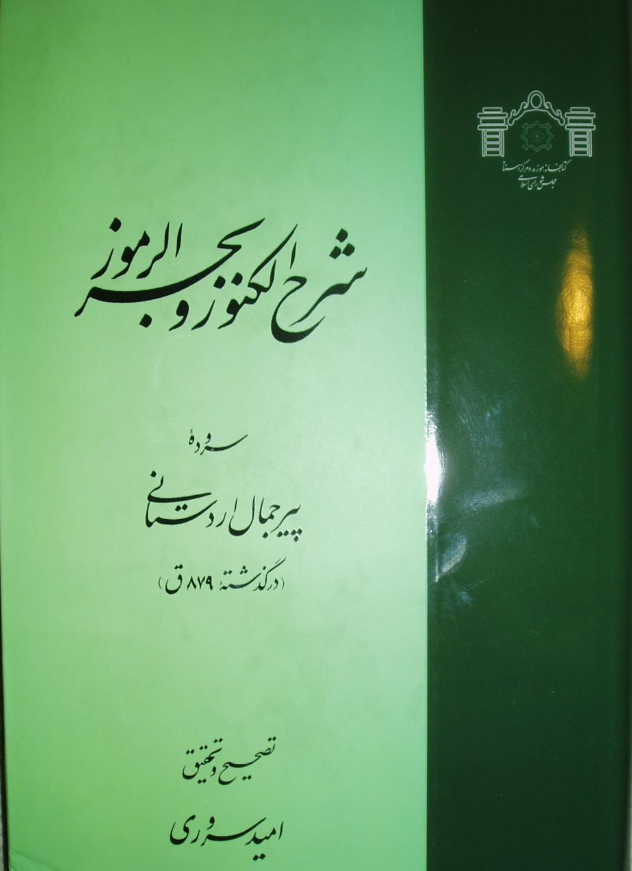

Sharh al-kunuz va bahr al-rumuz (see below) + Extract cited Nicholson, 1922 [EBG Fest 60th] p.369.
Pīr Jamāl al-Din Ahmad-Muhammad Ardistānī / پير جمال الدين اردستانى
- Kulliyat-i Pīr Jamāl ("The Compendium of Collected Works").
For useful details of a ms of this Kulliyat see Reynold A. Nicholson, "Pīr Jamāl" in A volume of Oriental studies : presented to Edward G. Browne, M.A., M.B.F.B.A., F.R.C.P., Sir Thomas Adam's professor of Arabic in the University of Cambridge on his 60th birthday (7 February 1922) edited by Sir Thomas Walker Arnold; Reynold Nicholson, pp.364-370. PDf, Nicholson, "Pīr Jamāl" : Pir Jamal.pdf
-
مرآة الافراد / Mirʼāt al-afrād. ed Ḥusayn Anīsīʹpūr. Tehran: Intishārāt-i Zavvār, 1371 / 1992 or 3. 422 pages. See Hathi Trust Digital Library...
"The contents of the India Office MS. [having 1518 pages] are as follows : 1. Mir'atu'l-afrad (pp. 1-128). A large number of risalat in prose and verse addressed to his disciples on points of Sufi doctrine and the interpretation of verses of the Koran. On p. 127 the writer describes a vision of angels which he saw on the 8th of Muharram, A.H. 877." (Nicholson, in 1922: 365).
- Kanz al--daqa' iq (pp. 129-175 )
- Misbah al-arvah. Anjaman-i asar va mufakhir-i farhangi
- Miṣbāḥ al-arvāḥ ed. Abū Ṭālib Mīr ʻĀbidīnī. Tehran : Anjuman-i Āthār va Mafākhir-i Farhangī, 1380/ 2001 or 2002. 229 pages.
- ديو ان = Dīvān-i Pīr Jamāl Ardistānī
- Sharh al-kunuz va bahr al-rumuz ["Commentary on the Treasuries and the Ocean of the Secret Enigmas"] / surudah-i Pir Jamal Ardistani; ed. Umid Sururi Jamali. Majlis-i Shura-yi Islami 1388/2009, Tehran, 1388/ 2009. 444,(7) pp. ISBN 10: 6005594117 / ISBN 13: 9786005594119
♦
ARABIC WORKS
The Fifteen (largely) Arabic works listed by the informants of Joseph Wolff.
[1] Koran = Qur’ān. The Holy Qur'an, the sacred book of the Islamic religion and of the Muslim world.
As is universally known the 114 Surah (loosely. "chapter") Qur'an or "Recitation" is an Arabic collection of the wahy, the allegedly divinely inspired revelations communicated by Gabriel to the Prophet Muhammad between c. 610 and his death in 632 CE. It has been memorized, written down, copied and published according to its canonical text for over 1,000 years.
[2] "Amsala" [sic.] = Amthila (loosely), "Arabic Accidence" or "Grammatical Paradigms" - the Arabic plural of mithal meaning, `example, lesson, parable, proverb, pattern, paradigm. This is a Persian work of al-Sayyid al-Sharīf ʻAlī ibn Muḥammad ibn ʻAlī al-Sayyid al-Zayn Abī al-Ḥasan al-Ḥusaynī al-Jurjānī al-Ḥanafī, 740-816 AH. More succinctly ʻAlī ibn Muḥammad Jurjānī (b. near Astarabad, 740 /1340.- d. Shiraz, 6th Rabi` al-Awwal, 816/1413), known as Sayyid al-Sharif and Mir [Meer]. He was a Ḥanafī Sunni Muslim who wrote slightly more than fifty books in Arabic and Persian. They include, for example,
ʻAlī ibn Muḥammad al‐Jurjānī (d. Shiraz, 816/1413).
- Tarjumān al-Qur'ān ترجمان القران : شامل لغات قران كريم و معاني فارسي آن - Tarjumān-i al-Qurān : shāmil-i lughāt-i Qurʼān-i Karīm va maʻānī-i Fārsī-i ān = ʻAlī ibn Muḥammad Jurjānī, al-Sayyid al-Sharīf; ʻĀdil ibn ʻAlī al-Ḥāfiẓ.; Muḥammad Dabīr Siyāqī ("Exposition-Translation of the Qur'an"). Tehran : Chāpkhānah-ʼi Ḥaydarī, 1333/ 1954. Available in HathiTrust Digital Library, 2014.
- Ṣarf-i Mīr = Amthila = Taṣrīf-i Sayyid-i Sharif = Bi-Dan (so Hajji Khalifah, Kashf al-zunun + so named in central Asia). See Storey, Per. Lit. III.1. p.156 No. 250 No.1). See further below for other printings and translations and note صرف مير مع تبصره وتکمله. Ṣarf-i Mīr maʻa tabṣirah va takmilah. Kānpūr / Cawnpore : Nawal Kishūr, 1884 (Persian),
- Nahw-i Mīr نحو مير (Persian). Referred to in Brockelmann -Joep Lameer HAL. II Supp. p. 317 "Naḥw i Mīr Cambr. 187,2, Bodl. 1604, 1618, As. Soc. Beng. 1457, II, 561,2.".
- Sharḥ al-Kāfiyya شرح الكافية (Persian). "A commentary on the treatise on Arabic syntax entitled al-Kāfiyah, by ʿUthmān ibn ʿUmar Ibn al-Ḥājib [1175-1249 CE]. Accompanied on the margin by glosses selected from the supercommentary of al-Sayyid al-Sharīf al-Jurjānī. Edited by Luṭfī Efendi.]" So `World Cat.summary'. .
- Sharḥ al-Sijājīyah fī ʻilm al-farāʼiḍ - Sirāj al-Dīn Muḥammad ibn Muḥammad Sajāwandī (fl. 12th cent CE) on Inheritance and Succession. شرح السراجية في علم الفرائض . Lakʹhnaw-Lucknow : Maṭbaʻat al-Yūsufī , 1320/1902-3. 160 pages.
- Sharḥ al-Sirājiiyyah : li-Sirāj al-millah wa-al-dīn, Muḥammad ibn Muḥammad ibn ʻAbd al-Rashīd al-Sajāwandī al-Ḥanafī, al-mutawaffá naḥw sanat 600 H . Beirut: Dār al-Kutub al-ʻIlmīyah, 2018.
- Sharḥ al-mawāqif = شرح المواقف. A commentary on ʻAḍud al-Dīn ʻAbd al-Raḥmān ibn Aḥmad al-Ījī;s system of scholastic theology, entitled al-Mawāqif fī ʻilm al-kalām. Published in Lakahnū-Lucknow : [publisher not identified], 1877 (so World Cat.).
- Sharḥ al-Wiqāya
- Sharḥ al-Miflāh
- Sharḥ al-Mawāqif fī ʻilm al-kalām شرح المواقف في علم الکلام Ed. + Introd. Aḥmad al-Mahdī. Cairo: Maktabat al-Azhar lil-Ṭibāʻah wa-al-Nashr wa-al-Tawzīʻ, 1977? 48, 422 pages.
- Sharḥ sharīf lil-Sayyid al-sanad ʻalá al-Mawāqif lil-ʻAllāmah ʻAḍud al-Millah wa'l-Dīn ʻAbd al-Raḥmān ibn Aḥmad al-Ījī al-Qāḍī, min fuḍalāʼ ʻaṣrihi wa-farīd dahrihi, nafaʻanā Allāh bihimā, wa-ajzala al-Mawlá mathūbāt muʼallifihimā. Constantinople: Maṭbaʻat al-Ḥājj Muḥarram Afandī al-Būsnawī, 1286/1869. Available in HathiTrust Digital Library, 2012. Copy in Princeton Univ. Library. See World Cat.
- Sharḥ al-Tadhkira of al-Tüsi
- Sharḥ al-Talkhis of al-Chigmīnī
- Hāshiyya al-Tafiīr of al-Baidāwī. الع الأنوار.Ṭawāliʻ al-anwār. ?? بيضاوي، عبد الله بن عمر. إصفهاني، World Cat. summary "A treatise on scholastic theology. Accompanied by a commentary entitled Maṭāliʻ al-anẓār, by Maḥmūd ibn ʻAbd al-Raḥmān al-Iṣbahānī. With marginal annotations by al-Sayyid al-Sharīf al-Jurjānī and others.]. Published in Constantinople 1888.
- الحاشية على الكشاف للزمخشري al-Ḥāshiyah ʻalá al-Kashshāf lil-Zamakhsharī. Beirut: Dār al-Kutub al-ʻIlmīyah, 2016
- Hāshiyya al-Hidaya,
- Hāshiyya al-Sayyid ʻalá al-Muṭawwal حاشية المطول : hādhihi ḥāshiyah maqbūlah wa-wāḍiḥah marghūbah ʻalá sharḥ al-Muṭawwal = حاشية السيد على المطول . Lucknow : al-Maṭbaʻ al-Yūsufī, 1312/ 1894-1895. A gloss on Masʻūd ibn ʻUmar al-Taftazānī's [c.1322- c, 1369] commentary on the Talkhīṣ al-miftāḥ. Also published Qumm : Manshūrāt al-Sharīf al-Raḍī, 1406/1985 or 1986 and in Beirutt : Dār al-Kutub al-ʻIlmīyah, 2007,
- Manāqib Khwaja Naqshband
- كتاب التعريفات = Kitāb al-taʻrīfāt according to World Cat, "76 editions published between 1253 and 2017 in 6 languages and held by 159 libraries worldwide".
- The التعريفات Kitab al-Taʻrīfāt of Jurjānī is an Arabic dictionary of philosophical and Sufi terms. Twenty editions were published between 1559 and 2017 in Arabic. They are held by at least 93 libraries worldwide (ibid.). A recent printing is Kitab al-Taʻrīfāt wa-yalīhi bayān risālah iṣṭilāḥāt al-Ṣūfīyah al-wāridah fī'l-Futūḥāt al-makkiyyah. Beirut : Dār Iḥyāʼ al-Turāth al-ʻArabī lil-Ṭibāʻah wa']l-Nashr wa'l-Tawzīʻ, 2017. 224 pages.
- Refer also to the Arabic volume with annotated Turkish translation, Seyyid Şerîf Cürcânî'nin Telvîh hâşiyesi. ( = Series:M.Ü. İlâhiyat Fakültesi Vakfı yayınları, no. 379). İstanbul : Marmara Üniversitesi İlahiyat Vakfı Yayınları, 2016
The Amthila or Ṣarf-i Mīr, etc.
Carl Brockelmann (1868-1956) in his originally German Geschichte der Arabischen Litteratur (1898 + 1902; Rep. Leiden: Brill 1937, 1943, 1996) and translated into English byJoep Lameer (Brill, 2014, 2016, 2017-8?) as A History of the Arabic Written Tradition, In Supplement, Vol. 2 (Rep. trans. Joep Lameer) p.317 there is reference to the, Ṣarf-i Mīr (= the Amthila) as a "Persian morphology of the Arabic language" . The following list of various libraries in which mss of this work can be found is given as follows: Berl. pers. 180/1, 1186, Paris Blochet II, 931,4, Ind. Off. Éthé 2406,11, Cambr. 176,5, Bodl. 1653/6, Rieu 335, Mashh. XII, 33,114, Bank. IX, 769, Būhār 201, printed in Jāmiʿat al-muqaddimāt Tehran 1298, in Majmūʿa, Calcutta 1805, lith. Lucknow 1844, 1288 (BOI, 147)." ( page 317)
Carl Brockelman + Joep Lameer (trans.) Geschichte der Arabischen Litteratur
"Brockelmann’s History of the Arabic Written Tradition offers bio-bibliographic information about works written in Arabic and their authors, with an emphasis on manuscripts from the classical period. This originally multivolume reference work is divided in chronologically organized sections, which are subdivided by literary genre. Individual entries typically consist of a biographical section and a list of the author’s works in manuscript and print, with references to secondary literature. The “Brockelmann”, now also available in English, ..."
- History of the Arabic Written Tradition (Handbook of Oriental Studies Section 1 The Near and Middle East). History of the Arabic written tradition / by Carl Brockelmann ; translated by Joep Lameer ; with a preface by Jan Just Witkam. Other titles: Geschichte der arabischen Litteratur. English | Handbook of Oriental studies. Section one, Near and Middle East (2014) ; vol. 117. Leiden ; Boston : Brill, 2016. (Series: Handbook of Oriental studies. Section one, The Near and Middle East ; volume 117 ). Originally published as Geschichte der Arabischen Litteratur in 1898 and 1902.
In Vol. III of his Persian Literature, A Bio-Bibliographical Survey - vol. III. Part 1 B. Grammar. Charles A. Storey (1888-1968) refers to the Amthila as the Ṣarf-i Mīr or the Nahw-i Mir (see below) as follows, also listing select commentaries and versifications (on pp.156-7 No. 250 No.1) :
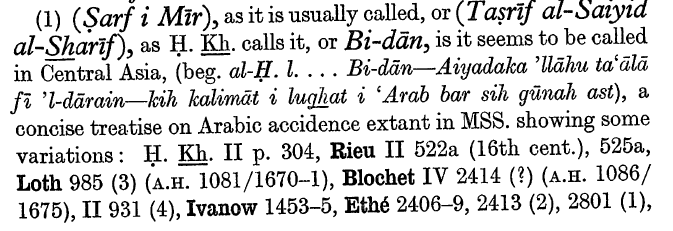
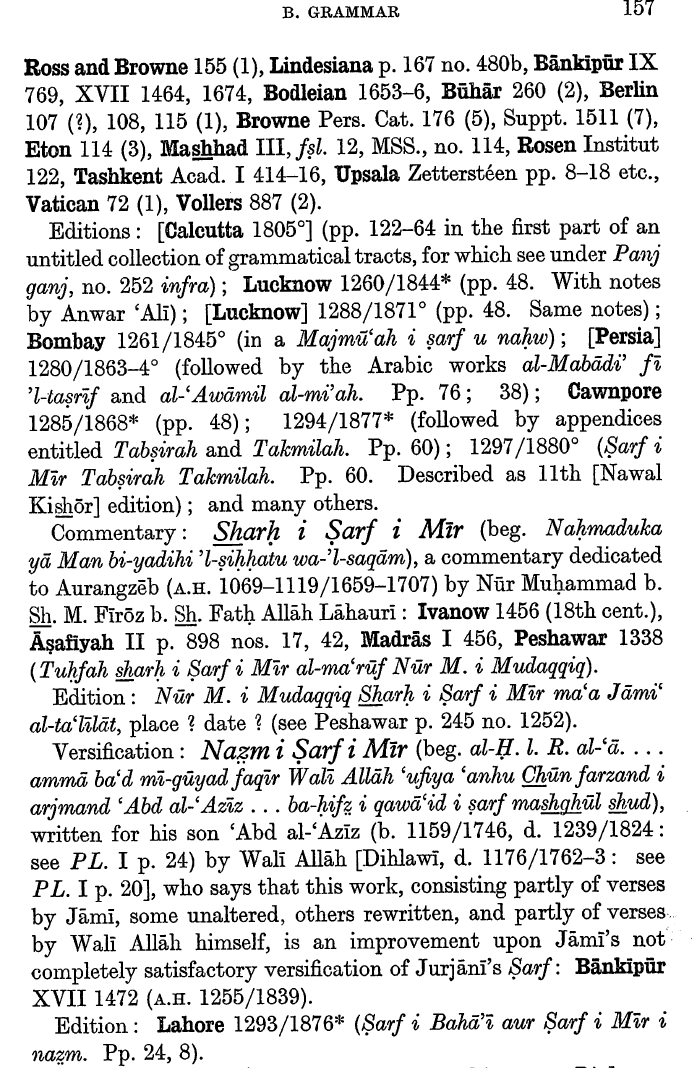
Ṣarf-i Mīr = Taṣrīf-i Sayyid-i Sharif = Bi-Dan (so Hajji Khalifah, Kashf al-zunun + so named in central Asia, see Storey, Per. Lit. III.1. p.156 No. 250 No.1).
Ṣarf-i Mīr is the title of a bilingual Persian-Arabic elementary text on Arabic accidence (the inflections of words; morphology, syntax, grammar…) by جرجاني، علي بن محمد، السيد الشريف ʻAli ibn Muhammad al-Jurjani (b. 740. - d. Shiraz, 6th Rabi` al-Awwal, 816/1413), This author was entitled Sayyid-i Sharīf (the Noble Sayyid) and Mir (or `Meer' meaning `Notable, Commander'). It was part of the madrasa curriculum and was first published from the early 19th century in India, Persia and elsewhere, e.g. Calcutta (1805), Lucknow (1843) and Bombay (1845), then slightly later in Tehran (1852, etc).
There are numerous mss. or copies of the Amthila in European amd international libraries.e.g. the collective British Library ms. volume of 385f. with texts in Arabic, Turkish and Persian = Or. 11.766. has Items 22 and 23 catalogued as :
- 22 al-Amthila al-jadida fi Bayan al-Lugha al-jayyida, or, al-Amthila al-Mukhtalifa min al-Farsi,
- Item 23. Amthila-yi Farsi.
Note also
جرجاني، علي بن محمد، السيد الشريف،
- صرف مير مع تبصره وتکمله = Ṣarf-i Mīr maʻa tabṣirah va takmilah.Kānpūr : Nawal Kishūr, 1884. In Persian. 56 pages (28cm) - so World Cat.
جرجانى، على بن محمد، السيد الشريف.
In recent times versions of the still widely used Amthila have been translated into English and other European languages and from their perusal an idea can be gained of the grammatical strictures the youthful Bab would have been expected to memorize and master.
لالي، احمد بن مصطفى
Note also the 1820s Arabic with Turkish commentary Kitāb Sharḥ amthila ("Book of the Commentary on the Amthila") of Aḥmad ibn Muṣṭafá Lālī. See Princeton ms. "Three grammatical treatises".
The Compendium al-ʿAwāmil fī al-Naḥw. العوامل في النحو. on Arabic Grammar and Syntax.
This work is "A collection of short treatises on Arabic grammar, in two parts.
Part 1, on the accidence, containing five works all in Persian, namely : Mīzān al-ṣarf, Munshaʿib, Panj ganj, all three anonymous ; Zubdat al-ṣarf, by Ẓāhir ibn Maḥmūd ʿAlavī, and Ṣarf i Mīr, by Sayyid Sharīf al-Jurjānī.
Part 2, on syntax, also containing five works, the first four in Arabic, the last in Persian, namely : Miʾat ʿāmil, by ʿAbd al-Qāhir al-Jurjānī ; the anonymous commentary thereon ; Aṣl al-jumal, al-Tatimmah, both anonymous ; and Naḥv i Mīr, by Saiyid Sharīf al-Jurjānī."(so World Cat.)
The composite compendium of works mentioned above thus contains - some anonymous -works in both Arabic and Persian collectively entitled العوامل في النحو, al-ʿAwāmil fī al-Naḥw. It contains works by persons unknown and the following three persons
- Ẓāhir ibn Maḥmūd ʿAlawī, Zubdat al-ṣarf ;
- ʻAbd al-Qāhir ibn ʻAbd al-Raḥmān Jurjānī, Ẓāhir ibn Maḥmūd ʿAlawī
- ʻAlī ibn Muḥammad Jurjānī, al-Sayyid al-Sharif = the two works: [1] Ṣarf-i Mīr of ʿAlī ibn Muḥammad Jurjānī. and [2] Naḥv-i Mīr of ʿAlī ibn Muḥammad Jurjānī.
Other works therein include :
- Aṣl al-jumal - anonymous
- Tatimmah - anonymous
- Mīzān al-ṣarf - Persian
- Munshaʿib - Persian anonymous.
- Panj ganj - Persian anonymous.
- Sharḥ Miʾat ʿāmil by ʿAbd al-Qāhir al-Jurjānī
Note also Commentaries on the `Awamil of al-Jurjānī, etc.
- شروح العوامل للشريف الجرجاني ومحمد بن بير علي البركوي.
- Shurūḥ al-ʻawāmil lil-sharīf al-Jurjānī wa-Muḥammad ibn Bīr ʻAlī al-Birkawī. Birgivî Mehmet Efendi. Beirut: Dār al-Kutub al-ʻIlmīyah, 2010. 606 pages. This work contains :
- [1] Tuḥfat al-ikhwān fī sharḥ al-ʻAwāmil al-miʼah lil-Birkawī / Muṣṭafá ibn Ibrāhīm al-Ghalībūlī
- [2] Sharḥ al-ʻiṣām ʻalá ʻAwāmil al-Birkawī / ʻIṣām al-Dīn Ibrāhīm ibn Muḥammad ibn ʻArabshāh --
- [3] Sharḥ ʻAwāmil al-Jurjānī / Saʻd Allāh al-Ṣaghīr --
- [4] Tashriḥ al-ghawāmil fī sharḥ al-ʻAwāmil lil-Jurjānī / Aḥmad ibn Muḥammad al-Faṭāmī.
The Bab and the Amthila
The Bab's probable early exposure to the grammatical Amthila is mentioned in a recollection of Mulla `Abd al-Khaliq Yazdi as cited by Fereydun Vahman - who at times draws on Amanat's Resurrection and Renewal (1982 and reprints) :
Mirza Sayyid 'Ali did not give up hope that the Bab might resume his formai education. The Bab was fifteen (c. 1834) when Mirza Sayyid 'Ali took him to one of the well-known Shaykhi 'ulamas, Mulla 'Abdu'l-Khaliq Yazdi, to leam the fundamentals of Arabic grammar and the principles of Islamic jurisprudence. Mulla 'Abdu'l-Khaliq Yazdi recounts the following in a conversation with Mulla 'Abdu'r Rahim-i-Qazvini:
I was a leader of prayer in Shiraz and held teaching lectures there. Once the uncle of this reverent man [i.e., the Bab] brought him to me saying that "this is a soul who is adomed with piety and austerity, but lacks leaming, and I beg you to pay him some attention." After I had admitted him, I left him in the custody of my younger son. A few days later, my son came back to me complaining that "the person you have left me has not accomplished any ofthe elementaries. He first must leam basic grammatical structure Amthila,18 and teaching Amthila is not suitable to my position." After that they sent him to Bushihr for the purpose of trade. Now I see such magnificent writings and unequalled verses as to make me astonished.419 (cited Vahman 2020: XX).
Nahw-i Mīr نحو مير (Persian).
Charles A. Storey in his Persian Literature, A Bio-Bibliographical Survey - vol. III. Part 1 B. Grammar. pp.157-8 also refers to the Nahw-i Mīr as follows:
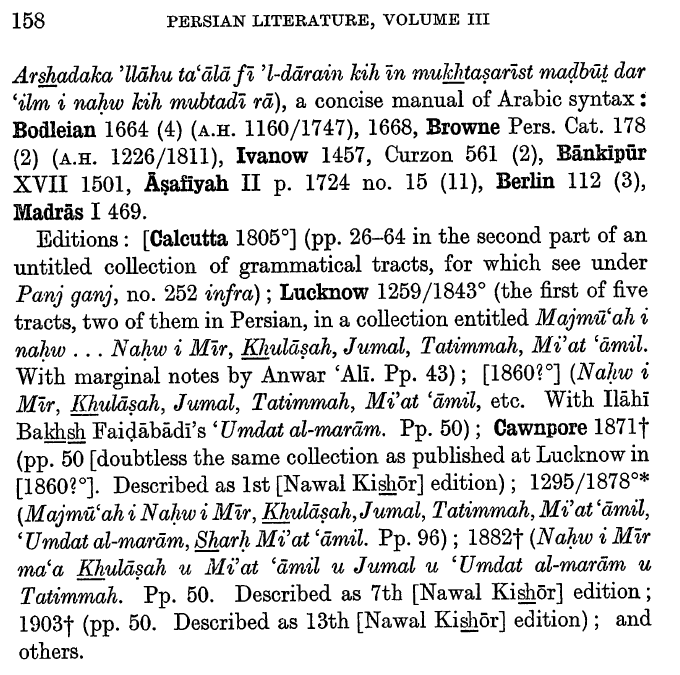
During the last five years or so a few English translations of the Amthila or a related grammar of al-Jurjani with the title Nahw Meer or more accurately Nahw Mir (`The Grammar of Mir [the Commander]") (see above) have appeared - Storey refers to this work on pp. 158-9 of Vol. III B (Grammar) which is cited above :
al-Sayyid al-Sharif, Ali ibn Muhammad al-Jurjani, Translator : Asrar Rashid
Hardback 144 Pages.
- Nawh Mir: A Primer in Arabic Grammar. Dar al-Imam Yusuf an-Nabhani, 2nd rev. ed. 2018. 144 pages. Downloadable in PDf from Archive. org.
- PDf,
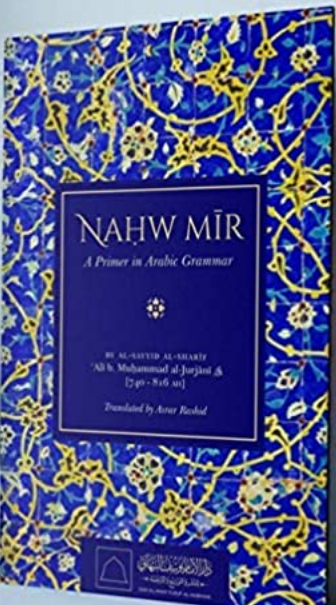
Mohammed Shamsuddin Khan Sajid (Trans.),
- 2016 (31st July). al-Sayyid al-Sharif Ali b. Muhammad al-Jurjani (740-816).. Nahw Mir: A Primer in Arabic Grammar. Translated by Asrar Rashid. Dar al-Imam Yusuf al-Nabhani, 2016. Hardcover volume 115 or 140 pages.
- Contains the following description : "This is the first ever translation of Nahw Mir from Persian to English. The work consists of twenty lessons detailing the intricacies of Arabic grammar and outlining the richness of Arabic language. Throughout history, thousands of Muslim scholars [ Ulama'] in the Indian Sub Continent and Central Asia have commenced their studies with the work 'Nahw Mir'. When study of the Persian language dwindled in India, many scholars took it upon themselves to translate this work into the Urdu language. With the introduction of the Nizami Syllabus among English speaking people, the need arose for a simple translation of this concise yet immensely beneficial text. This text is preferred over modern grammar books because of its simplicity and brevity. The work 'Nahw Mir' is authored by al-Sayyid al-Sharif Ali b. Muhammad al-Jurjani [740 - 816 AH] who was born in the city of Jurjan on the 22nd of Sha ban in the year 740AH. He attained his religious education from the foremost authorities of his time, namely al- Allama Mubarak Shah and al- Allama Akmal al-Din Muhammad b. Mahmud al-Babarti. Under the guardianship of such reputable luminaries, he became known by two epithets; "al-Sayyid al-Sanad" and "Mir Sayyid". Table of Contents: Transliteration Key, Foreword, Biography of Imam al-Jurjani, An Introduction to Nahw Mir, Guidelines for Teachers on How to Teach Nahw Mir, Author's Introduction.". Available from Amazon books.

- 2018 Nahw Meer: An English Guide to Arabic Semtences. An authoritative Book on Nahw by Meer Syed Jurjani. Also named as Meer Syed Sharif Abul Hasan `Ali ibn Mohammed al-Jurjani. 770-616 AH and Malik Abdul Waheed bin Malik Abdul Haque 142 Pages and 7 Pages for Notes. Contains the following introductory words, "First Meer Ali ibn Mohammed Al-Jurjani, the Author of Nahw Meer, does not need any introduction. His masterful book has been in use for centuries mostly in it's original language of Persian and it's Arabic and Urdu translations and it is taught in many schools in Indian subcontinent and other parts of the world. I felt, that there is a need for a literal translation in today's English for those of us who are more comfortable with it."
- 2018 "Arabic Grammar Nahw Meer English: Arabic Language Nahw Study Paperback – Large Print, April 24, 2018". Availabe on Amazon books...
Joseph Wolff continued:
[3] “Tasreef” = Taṣrīf in Arabic means "change, alteration, inflections, declensions, conjurgations". etc. Note also (from the same triliteral root ṣ-r-f) that the verbal-noun ṣarf also can have the same or similar grammatical senses including "alteration, inflection, declension and conjurgation", etc.
A composite Persian volume entitled Kitāb al-Taṣrīf. A︠wāmil-i manzūma. A︠wāmil-i Molla Muḥsin. A︠wāmil-i Jurjānī. Sharḥ A︠wāmil-i Jurjānī. is mentioned in World Cat without details of the publisher(s), or date of publication- though 1284 AH/ 1867 CE is mentioned.
[4] “Sharea Tasreef” = [?] Sharḥ-i Taṣrīf perhaps indicative of al-`Izzi or Mas`ud ibn `Umar al-Taftāzānī (d.791/1389).
This may be the work which exists in a mid. 19th century lithograph printing listed by Adam Gacek in his Arabic Lithographed books (Montreal: McGill University Libraries, 1996) page 190 No. 342:
"Sharḥ-i Taṣrīf [al-'lzzī] \ Mas'ūd ibn 'Umar al-Taftāzānī (d.791/1389).-- pp.(155].-- Commentary on the work of 'Izz al-Dīn 'Abd al-Wahhāb ibn lbrāhīm al-Zanjānī (d.625/1257).-Transcribed in Ramadān 1272/1856.-- Glosses in Nasta'līq hand executed by ('ala yad) Muhammad 'Alī ibn 'Abd Allāh al-Tihrānī, Dhū al-Ŗijjah 1272/1856.-- Printed in Iran in or after 1272/1856.-- Ref. McGill 220; Princ 3504.-- (ALA.T124s)."
[5] “Sharah Marah” [sic.] = Sharḥ-i Marāḥ al-arwāḥ by Aḥmad ibn ʻAlī ibn Masʻud (fl. 7th /13th cent. CE), a commentary on a massively important work on Arabic morphology and phonology.
For details see : World Cat. https://www.worldcat.org/wcidentities/lccn-n90668985
ابن مسعود، أحمد بن على, قرن = Aḥmad ibn ʻAlī ibn Masʻud, ابن مسعود، أحمد بن علي. زنجاني، عبد الوهاب بن إبراهيم. أبو حنيفة
- مراح الأرواح،
- Kitāb Marāḥ al-arwāḥ wa-yalīh Kitāb ʻArabī, wa-yalīh kitāb al-Maqṣūd, wa-yalīh kitāb al-Binā ... Cairo: 1254/1838.
- See Hathi Trust Digital Library, for Full view کتاب المراح. ed. عبد الوهاب بن إبراهيم. أبو حنيفة `Abd al-Wahhab ibn Ibrahim Abu Hanifah. [Cairo] Būlāq : al-Maṭbaʻah al-Khidīwīyah, 1252/ 1836 + 1282/1866. 111 pages.
Kitāb al-marāḥ - see Hathi Trust.
مراح الارواح مع حواشي جديدة / Marāḥ al-arwāḥ maʻa ḥawāshī jadīdah. Dahlī : Maṭbaʻ Mujtabāʼī, 1902. 96 pages. See HathiTrust Digital Library...
Aḥmad ibn ʻAlī ibn Masʻud ; Joyce Åkesson:

- Arabic morphology and phonology : based on the Marāḥ al-arwāḥ by Aḥmad b. ʻAlī b. Masʻud (= Studies in Semitic languages and linguistics, 35.). Leiden, Brill. 2001. xii-444 pages. consists of an introduction, Arabic edition, English translation and commentary by Joyce Åkesson. There was also a 1990 earlier partial printing in Arabic, German and English. Summary " "This volume provides with an exhaustive study of Arabic morpho-phonology based on the 13th century complete work written by Ahmad b. 'Ali Mas'ud; the Marah al-arwah , which is critically edited and provided with an introduction, an English translation and an extensive commentary".
[5] May also be : Sharḥ al-Marāḥ fī al-taṣrīf = شرح المراح في التصريف li-Badr al-Dīn Maḥmūd ibn Aḥmad al-ʻAynī [1361-1451]; ḥaqqaqahu wa-ʻallaqa ʻalayhi ʻAbd al-Sattār Jawād. Cairo: Muʼassasat al-Mukhtār, 2007.
[6] “Jaa Barde”
[7] “Sharah Uamal” = [?] Sharḥ al-'Amal... ??
[8] “Hedayat” = [?] هداية النحو و بداية النحو perhaps the Arabic grammar entitled Hidāyat al-naḥw : maʻa Bidāyat al-naḥw of Sirāj al-Dīn al-Awdhī ( ).
Perhaps the work listed by Adam Gacek in his Arabic Lithographed books (Montreal: McGill University Libraries, 1996) page 57 No. 81:
No. 81 = Hidāyat al-nahw \ Sirāj al-Dīn al-Awdhī.-- pp.1-143. Numerous marginal glosses in Nasta'līq hand.-- Pririted by (biihtimām) Muhammad 'Abd al-Rahmān ibn Muhammad Rūshan Khān at the request (hasba farmāyish) o fMuhammad Sa'īd Sāhib, Kānpūr (Cawnpore), Matba'-i Nizamī, n.d. (ca.1273/1856-7, see the printer's seal).-- Followed by Bidāyat al-nahw (no.23).--Ref. GAL SI, 535.-- (ALAG.A945h).-- Fig.23.
Sirāj al-Dīn al-Awadhī,
-
Hidāyat al-naḥw : maʻa Bidāyat al-naḥw, Kānpūr Cawnpore : Maṭbaʻ-i Niẓāmī, 1897, Free Download on Archive, org, Borrow, and Streaming : Internet Archive deriving from McGill University Library (Montreal, Canada),
Other possibilities for No.8 here include
[9] “Anmoosaj”
[10] “Sharah Karr” Shaykh Baha'i Sharh-i Add
[11] “Sayyote” = ? `Abd al-Raḥmān ibn Abī Bakr ibn Muhammad, Jalāl al-Dīn, Abū al-Faḍl al-Ṣuyūṭī. عبدالرحمن بن أبي بكر بن محمد جلال الدين السيوطي This is most likely an Arabic work of the extremely polymathic Egyptian scholar, commentator and hadith expert Jalāl al-Dīn, al-Ṣuyūṭī (c. 844-911 AH = c. 1445–d. Cairo, 1505 CE). Perhaps his Al itqān fi `ulūm al Qur'ān ("Certainty regarding the Sciences of the Qur'an"). It might perhaps refer to the well-known Tafsir Jalālayn (Qur'an Commentary of the two Jalāls, Jalāl al-Dīn, Muhammad ibn Ahmad al-Mahalli d.861/1459 and Jalāl al-Dīn al-Ṣuyūṭī) or tp one of his al-Ṣuyūṭī's legalistic works.
[12] “Sharah Jame” = Sharḥ-i Jāmi ...
[13] “Mabsoot” [sic.] = Arabic, المبسوط al-Mabsūṭ, المبسوط في فقه الإمامية.
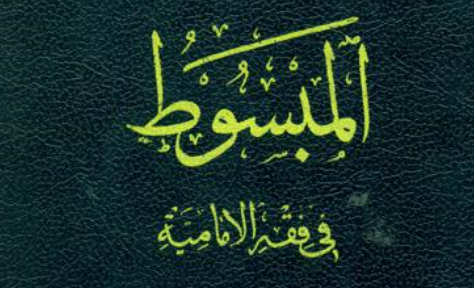
This is most likely the Arabic المبسوط في فقه الإمامية - al-Mabsūṭ fī fiqh al-Imāmiyya a multi-volume work of Shi`i or Imami jurisprudence with anciliary materials written by Abū Jaʿfar Muhammad ibn al-Ḥasan ʿAlī Ṭūṣi = Shaykh al-Ṭūsī / al-Ṭā'ifa (b. 385-460 = d. 995-1067-68),
See Āqā Buzurg al-Tehrani, al-Dharīʿa,19:54.
Publications of المبسوط في فقه الإمامية
- Al-Mabsut fī fiqh al-Imāmiyya... Lithographin the handwriting of Muhammad 'Ali Khwansari. ed. Mirza Masih in 1270/1853-54.
- Al-Mabsut fī fiqh al-Imāmiyya..: Tehran: 1855, Lithograph, 345 folios.
- Al-Mabsut fī fiqh al-Imāmiyya..: Tehran: al- Matba`at al-Haydariyya ,,, 8 vols. ?
- Al-Mabsut fī fiqh al-Imāmiyya... ed. Muḥammad al-Bāqir Bahbūdī in 8 vols., 3rd printing (2992 pages) al-Maktabat al-maktabah al-murtaḍiyyah li-Iḥyāʼ al-Āthār al-Jaʻfarīyah, 1387/1967-68 + 1351 Sh./1972. Includes marginal comments by Muhammad Taqī Kashfī.
All eight vols. of the 3rd printing available in PDf. on Archive. Org.
These weighty Fiqh vols open with a Kitab al-Ṭahārah (`The Book of Purity') which, among many other things, includes directives regrading impure things (e.g. blood) and the manner of their purification.
♦



